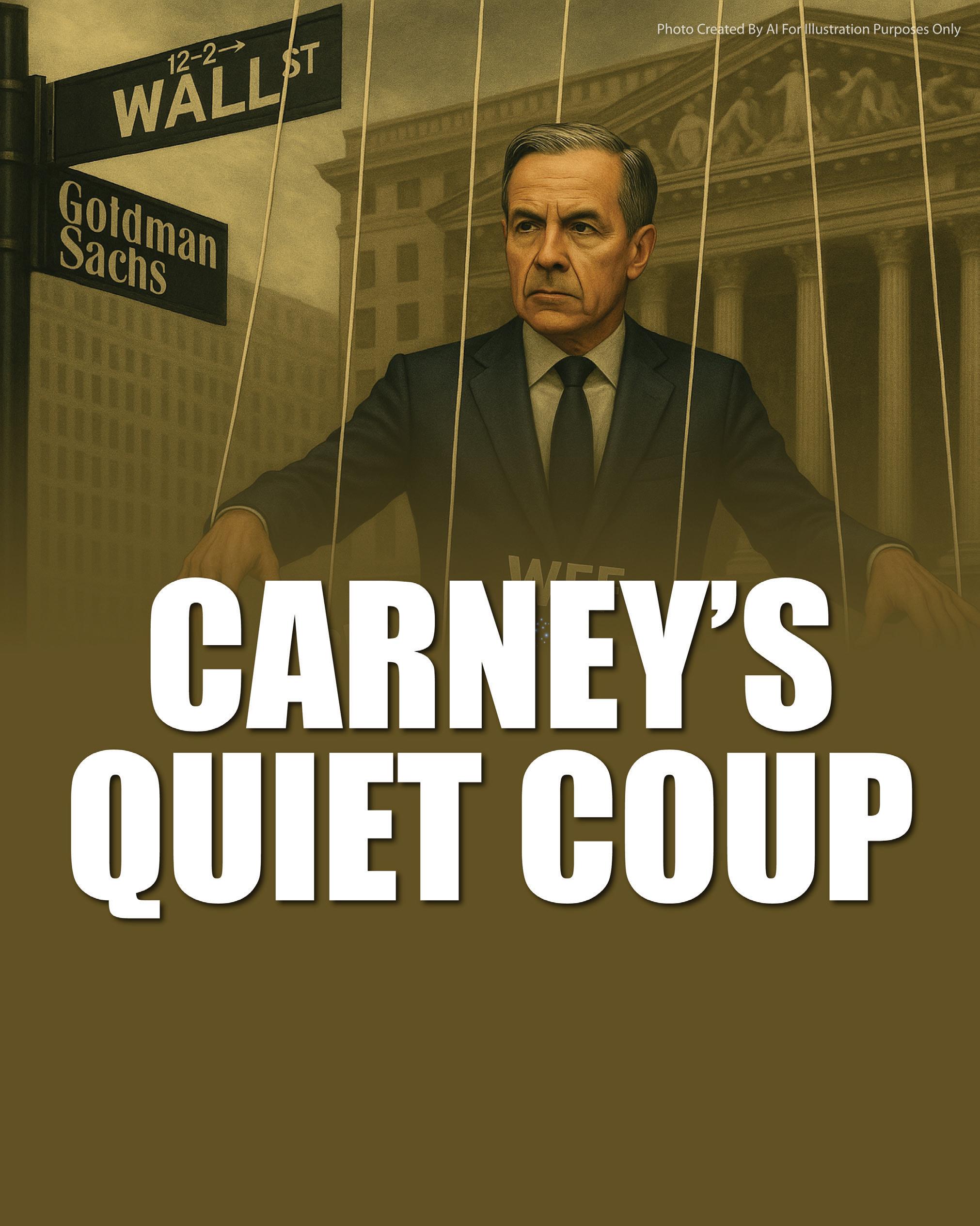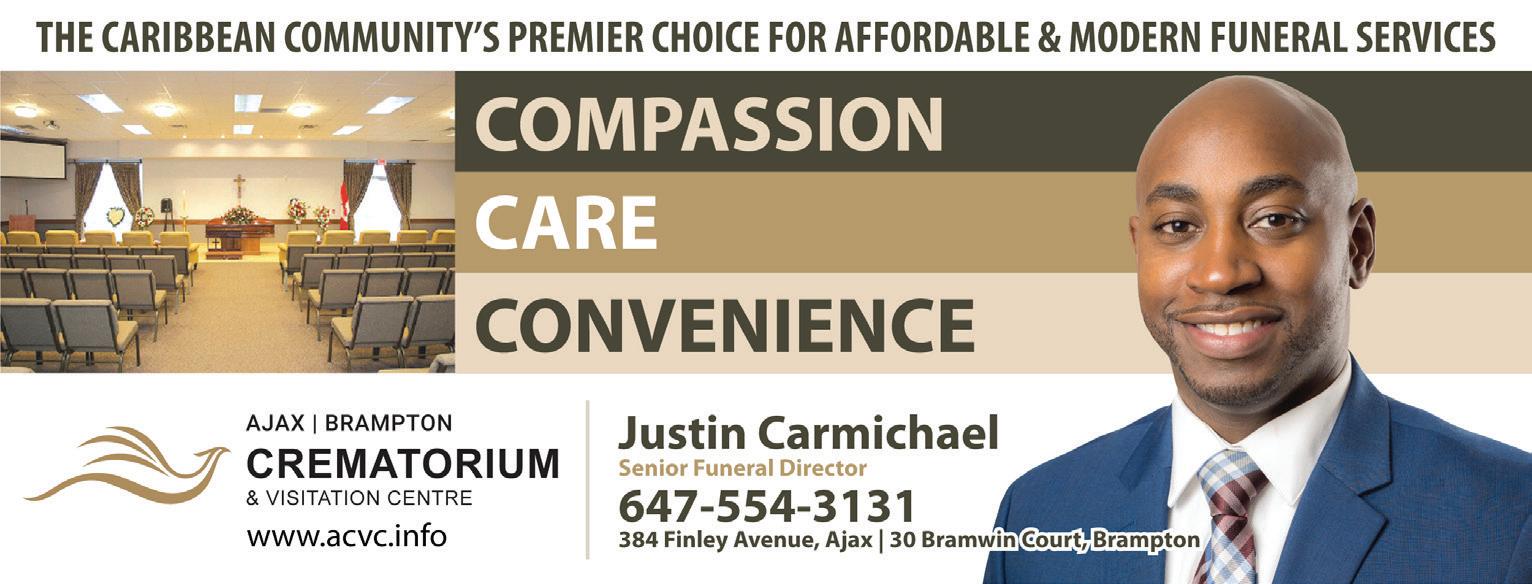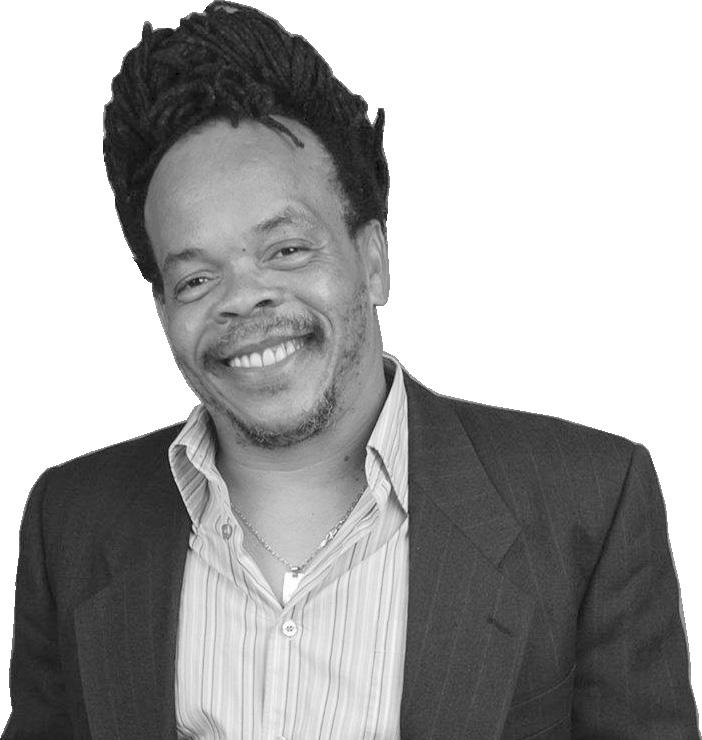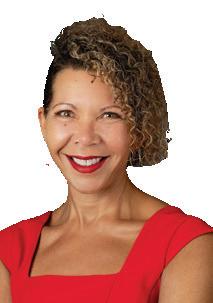









“His “progressive” rhetoric masks policies that transfer wealth from working families to financial elites, the exact colonial pattern Caribbean people have faced for centuries...”













“His “progressive” rhetoric masks policies that transfer wealth from working families to financial elites, the exact colonial pattern Caribbean people have faced for centuries...”


In a sunlit studio tucked away, swatches of vibrant Ankara fabric lay beside sleek MacBook spreadsheets. This is the world of Doyin Amao, a woman who refuses to choose between creativity and corporate brilliance. At first glance, she may appear to be a walking paradox: an MBA graduate from Rotman School of Management, a certified Chartered Accountant (ACCA), and an AI Product Manager who moonlights as a fashion designer, but look a little closer, and you’ll find a woman full of passion, heritage, and a love for fashion.
Doyin’s story doesn’t begin in a boardroom. It begins in Oyo State, Nigeria, where a little girl with big eyes watched her mother transform into magic every morning with bold style and flowing prints. “My mom has been fashionable my entire life,” she recalls. “I used to use scraps of fabric to remake her outfits on my dolls.” Those scraps weren’t discarded remnants to Doyin, and in them, she found the seeds of a creative empire long before she knew the words “business strategy” or “digital transformation.”
At just 16, while most teenagers were dreaming of concerts and curfews, Doyin had a different wish for her birthday, fashion school. Her parents, understanding the uniqueness of their daughter’s vision, supported her in every way. Her father, in particular, became a quiet architect of her future. “He would tailor his own clothes and tell the tailor to keep the scraps for me,” she says. “He’s the one who found the fashion school for me to go to when I was 16. He believed you could be a professional and still create.”
This balance between precision and passion would become the hallmark of Doyin’s life.
After earning a BSc in Accounting from Covenant University, Doyin carved a formidable path in the world of finance and business. She mastered the language of numbers, systems, and scalable models. Her analytical mind found joy in structure, but her creative spirit never dulled.
Doyin would go on to earn an

MBA from the University of Toronto’s Rotman School of Management, adding another pillar to her growing empire. Her career skyrocketed. Over the span of nearly a decade, she became known as a strategic powerhouse in product management, digital transformation, customer experience, and business strategy. From leading over 80 high-impact initiatives to generating multi-million-dollar returns through operational innovation, Doyin became the go-to leader for companies navigating disruption.
Her business philosophy is as bold as her wardrobe: data meets intuition, and innovation must serve people. Whether she’s optimizing global supply chains, or guiding startups through digital revolutions, her goal remains the same: human-centered solutions with lasting impact, and yet, for all the accolades, Doyin never lost touch with the girl who sewed clothes from scraps. That girl had simply grown into a woman now designing collections under her brand, OAMA, that are worn around the world.
In 2019, a serendipitous conversation changed everything. She was planning a trip, and a friend suggested creating travel-inspired pieces to capture the spirit of the journey. The idea sparked something deep inside her. “Whenever you’re trying something new, exploring a new place, I think you should do it looking fabulous,” she says with a smile.
That sentiment (equal parts style and substance) became the core of OAMA: her fashion label that blends cultural heritage, modern femininity, and bold storytelling. OAMA is about where a woman is going, both literally and figuratively.
The design process starts with a print. “Once the print is designed, I begin to put things together,” Doyin explains. “What type of outfit should I create? Where is the woman who is wearing it going?” From her sketches in Toronto to manufacturing in Lagos, to shipping across the globe, every stitch tells a story.
Perhaps the most beautiful

element? Her fashion journey is rooted in family. Her brand name, OAMA, is a clever rearrangement of her father’s surname, a subtle nod to the man who believed she could do it all. “We are rooted in heritage,” she says. “The joy of my family is behind this.”
For Doyin, success isn’t just personal, “I want us to be remembered as a brand and a community that has done the work to understand the industry,” she explains. “We’re accessible, rooted in culture, and deeply intentional.”
Whether mentoring founders, managing product teams, or designing limited-run collections, Doyin leads with purpose and power. Her presence is magnetic, her mission transformational.
When asked what her younger self would say to the woman she’s become, Doyin’s answer is quietly powerful, “Keep going!”
She admits there are hard days; moments when no one sees your work, when doubts echo louder than dreams, but she’s come to learn that someone, somewhere, is watching, and when they see you walk in your truth: brilliant, bold, and unapologetic, it gives them permission to do the same.
Doyin Amao is more than her titles: ACCA, MBA, CSPO, CSM, AI Strategist, Fashion Designer, Consultant; she is proof that you don’t have to choose between the boardroom and the runway, between algorithms and art.
She’s the embodiment of modern African excellence: unafraid, unconventional, and unforgettable. From the chalk-lined sewing tables of her teenage years to executive boardrooms across North America, Doyin has stitched a life that is as fearless as it is fashionable. The best part? She’s only just begun…




Artificial Intelligence is everywhere right now, from classrooms to courtrooms, from our pockets to our workplaces. For the Afro/ Indo Caribbean community in Toronto, the promise of generative AI (gen AI) is doubleedged: it can be a powerful equalizer in access, productivity, and professional polish, but it also has the potential to dull our drive, our passion, and even our sense of purpose.
A groundbreaking new study led by researchers: Yukun Liu, Suqing Wu, Mengqi Ruan, Siyu Chen, and Xiao-Yun Xie sheds light on a critical dynamic we need to understand while AI makes us faster and sometimes better at our jobs, it can also make us less motivated, especially when we return to tasks that don’t involve AI.
Let’s break this down in plain terms and connect it back to our community.
Across four studies with over 3,500 participants, researchers asked people to perform typical workplace tasks like: writing emails, brainstorming, or drafting reviews, with and without AI. Here’s what they found:
• Performance goes up when you use gen AI. The writing was sharper. The tone was warmer. The messages were clearer.
• Motivation goes down when people
move on to tasks without AI. In fact, intrinsic motivation dropped by 11%, and boredom went up by 20%.
In other words: Gen AI helps us slay the task in front of us but leaves us dragging when we return to work that requires our own: creativity, focus, and decision-making.
If you are Afro/Indo-Caribbean, or a proud mix of all three, you know the hustle. Our community has always found ways to do more with less. AI feels like a welcome addition to that toolkit until you realize it might be eating away at the very thing that made your grind unstoppable: your inner fire.
Imagine an entrepreneur from Little Jamaica using gen AI to build a flyer, or social media post. The job’s done in minutes, but the next task (like writing a grant proposal from scratch, or handling customer concerns) feels heavier. Why? AI took care of the hard thinking before, and now your brain has to do the heavy lifting alone. That sudden shift can lead to boredom, disconnection, and even burnout.
Here’s what’s happening under the surface:
1. AI does the thinking for you on certain tasks.
2. You feel less in control, which lowers your connection to the work.
3. When you return to solo work, your brain misses the shortcut, and you lose motivation.
This is especially important for Afro/Indo professionals and creatives who already have to fight harder for recognition and opportunity. If we become dependent on AI for the “polished parts,” we risk losing our

edge in areas like critical thinking, problemsolving, and storytelling, skills that can’t be outsourced.
Here’s the good news: Gen AI isn’t the enemy. Like any tool, it just has to be used with intention. The researchers offer five solid strategies that we can adapt to our community context:
1. Blend AI with your voice: Use AI to sketch ideas, not finish them. Let it spark you, but you add the soul.
2. Reclaim solo work as creative space: Don’t see non-AI tasks as chores. Use them to flex your own thinking, vision, and innovation.
3. Talk about it: Be transparent in the workplace, or in your own business about where AI helps, and where it doesn’t. Let others know your value isn’t in pressing “generate,” it’s in what you do with what it gives you.
4. Switch it up: Mix up your workflow. Start with challenging, solo tasks in the morning (when your brain is fresh), and use AI tools later for: formatting, editing, or refinement.
5. Build AI skills, but keep your core: Learn to prompt like a pro, yes, but also ask: Can I still do this on my own? If not, take a moment to re-learn it. Your creativity is worth preserving.
This research reminds us that while AI can elevate our output, it can also chip away at our passion if we’re not careful. Let’s use it smartly; like the griots, builders, and visionaries our ancestors were. Let it support the work, but never let it replace the heart behind it.
After all, the future of work is Afro/ Indo Caribbean inspired, and human led. Stay sharp. Stay human.














simone@carib101.com
“This is a call to action for every: industry leader, policymaker, and grassroots visionary in Canada.”
The red carpet shimmered with intention. Beneath the crystal chandeliers of the Great Canadian Casino Resort Toronto, some of Canada’s most powerful changemakers gathered to celebrate impact. The 2025 National Building Diversity Awards (BDA) and Community Benefits Summit, presented by the Toronto Community Benefits Network (TCBN) and Desjardins, was a declaration: equity, inclusion, and community are no longer side notes in Canada’s construction and development sectors.
As this transformative two-day experience unfolded on May 29th – 30th, it became abundantly clear that the movement for inclusive economic growth is alive, thriving, and being led by some of the most passionate individuals and organizations across the country.
May 29th, 2025 was an unforgettable evening. Kicking off with a VIP reception that buzzed with energy, the Building Diversity Awards set the tone with powerful performances from Canada’s leading artists and riveting tributes that underscored what this night was really about; recognizing those who are building a better Canada from the ground up.
Among the honourees:
• Chris Campbell, who was presented the Legacy Award, brought the room to its feet. A three-decade veteran of the construction industry, Campbell’s leadership ( from the Carpenters’ Union Local 27 to his community-building volunteerism) has carved a path for: African-Caribbean, Indigenous, and racialized youth. His unwavering dedication is a masterclass in what it means to lead with integrity.
• Wade Whittle received the Mentors Building Award for his grassroots work. His efforts exemplify what happens when mentorship meets mobility: community members gain careers, not just jobs.
• Canadian Turner Construction stunned many with its Leading on Diversity Award, revealing a 58% diverse workforce in 2024, surpassing Toronto’s demographic average.
• Judy Brooks was recognized for revolutionizing Metrolinx’s community programs, delivering 1,700+ jobs and $171.2 million in economic benefits to historically excluded populations.
Other standouts included: Skills Ontario, BC Infrastructure Benefits, Ticha Albino of IBEW 353, and Neil Lowhar’s ProPlanix Consulting Group, who earned the Diverse Contractor to Watch Award. Each winner demonstrated that real change in construction and infrastructure comes from intentional design, the kind TCBN has championed since its founding.
Casino Woodbine, stepping up in a big way, also donated $10,000 to further the cause, a reminder that private sector allies play a critical role in this work.
On May 30th, 2025, the conversation deepened at the National Community Benefits Summit hosted at the North York Central Library. With dozens of sector leaders, municipal

reps, nonprofit innovators, and tradespeople in attendance, this summit felt like a people’s parliament
The day’s keynote, Dr. Wendy Cukier, brought the heat. Her talk, “Building Canada – Advancing Equity, Diversity and Inclusion in the Face of Backlash”, was a fierce reminder that the progress we’ve made is not guaranteed. From panel sessions on social procurement, green jobs, and affordable housing strategies, to policy insights by Sarah Buchanan and Candice Zhang, the summit offered practical frameworks for: cities, unions, and developers to ensure public dollars serve public good, especially in racialized and underserved communities.
The Power of Community Benefits Agreements (CBAs)
At the heart of the BDA and Summit was a simple, but revolutionary idea: when governments invest billions in public infrastructure, the returns should include good jobs for locals, contracts for diverse small businesses, and longterm prosperity for marginalized communities.
This is the promise of Community Benefits Agreements (CBAs), and the Toronto
Community Benefits Network has redefined the construction industry’s moral compass. Founded in 2013, TCBN now represents 120 organizations and a community of over 20,000 supporters. Their flagship NexGen Builders program has helped thousands enter the trades, many of them racialized youth, women, and newcomers.
With incoming board chair Mark Russo, Executive Director Rosemarie Powell, and a fierce coalition of allies, TCBN is positioning itself to lead Canada into a new era of inclusive development, where community voice is essential.
This year’s Building Diversity Awards and Community Benefits Summit reminded us that visionary work is possible when: communities lead, partners listen, and systems change. If this is what embracing the possibilities looks like, then Canada (and the Caribbean communities within it) have much to be hopeful for.
“We’re not just building infrastructure,” said Rosemarie Powell. “We’re building futures.” To learn more or support the movement, visit www.communitybenefits.ca


There’s something deeply special about a community that shows up for each other. Whether it’s attending a local event, sharing a neighbour’s business post, or choosing to spend your money with someone from the community, every little act counts. And while the world has changed in so many ways over the past few years, one thing remains constant: we still need each other.
At Toronto Caribbean Newspaper, we’re proud to be more than just a publication—we’re a platform. A platform built on culture, connection, and community. And one of the most impactful ways to keep that platform strong is through advertising. Now, I know “advertising” might sound like a business buzzword, but when you strip it down to what it really means, it’s simple: it’s how we support each other. It’s how we share our stories, promote our work, and make sure our voices are still being heard—loud and clear.
Whether you’re a small business owner, an event organizer, a service provider, or just someone with a story to tell, advertising is a way to plant a flag and say, “I’m here. I exist. I’m part of this community.” That matters—especially now.
We’ve all seen how quickly things can shift. Businesses are closing, costs are rising, and people are being forced to make tough decisions about where they spend their time, energy, and money. That’s why visibility is more important than ever. If people don’t know you’re out there, how can they support you?
Advertising in Toronto Caribbean is about more than just buying space on a page. It’s about investing in a relationship. It’s about making sure our readers—your neighbours, customers, and extended family—see the faces and names that make up this vibrant Caribbean-Canadian community.
And here’s the beautiful part: every ad helps someone else. When you advertise with us, you’re not just promoting your business—you’re helping us keep this publication alive. You’re helping us deliver stories that reflect our lives, highlight our heritage, and give a platform to voices that too often go unheard in mainstream
media. You’re helping us shine a light on youth, artists, small business owners, and community champions who deserve recognition.
Now more than ever, print matters. With so many restrictions and new bills being passed around what can be said—and who gets to say it—online platforms are becoming more tightly controlled by algorithms and policies that don’t always serve our community. Messages can be shadowbanned, silenced, or simply not shown. But the beauty of print is that it cannot be censored. Our pages are real, tangible, and immune to filters. We remain the voice of the voiceless—unapologetically Caribbean, proudly independent, and deeply rooted in truth. That’s something worth protecting.
We’ve always tried to keep our ad rates reasonable, because we understand the challenges so many of you are facing. We’re not a big corporation—we’re a family-run paper with deep roots and real heart. When you reach out to us, you’re talking to real people who care. We’ll work with you, brainstorm with you, and help craft messaging that reflects who you are and what you offer. We want you to succeed—because your success is our community’s success.
So if you’ve been on the fence about advertising, consider this your gentle nudge. Not because we need it (although it truly helps us keep going), but because you deserve to be seen. Your work, your vision, your hustle—it all deserves a spotlight.
Let’s stop waiting for the “perfect time.” Let’s stop assuming people already know what we do or who we are. Let’s show up, boldly and unapologetically. Let’s build each other up the way our parents and grandparents built communities from scratch with little more than grit, grace, and the belief that we were stronger together.
To all our current advertisers: thank you. To everyone who picks up a copy of the paper, shares a story, or refers a friend—thank you. And to anyone thinking about making that first step—we’re here when you’re ready. Let’s continue to grow this community, together.


















simone@carib101.com
TC REPORTER
There’s something stirring in the warm winds of St. Kitts and Nevis; something bigger than sun, sea, and sand. A homecoming. A movement. A call, and it’s echoing across the ocean to Caribbean hearts worldwide.
At the heart of this cultural revival is the Honourable Marsha Tamika Henderson, Minister of Tourism, Civil Aviation, and Urban Development for the Federation of St. Kitts and Nevis. During our recent interview, Minister Henderson exuded warmth and pride as she unveiled an ambitious new diaspora campaign—one that was officially launched during the highly anticipated ANSA Reunion 2025 (May 23rd–25th) in Toronto.
“This campaign,” she shared with conviction, “Is a call for our people in the
diaspora, whether born on the island or descendants of islanders, to return. Take a vacation. Reconnect. Rebuild bonds and reimagine what it means to belong.”
Held at the Chelsea Hotel, ANSAReunion 2025 promised a weekend of reconnection and celebration rooted in shared Caribbean heritage. Founded in Montreal in 1983, ANSA (Anguilla, Nevis, and St. Kitts Associations) has long been a powerful link for diaspora members devoted to giving back to their homelands, but this year’s reunion, Minister Henderson says, is different.
“It’s urgent,” she explains. “The time is now. We are reuniting to reimagine what investment, identity, and inclusion look like for Caribbean people globally. We’re inviting people to come home; we’re creating a framework for them to stay connected.”
Tying into the campaign is “Summer Unscripted”, St. Kitts’ fresh tourism initiative encourages travelers to explore the island spontaneously with hotel deals, immersive experiences, and curated adventures that let the island reveal itself in real time.
I asked Minister Henderson to describe her perfect “unscripted” summer day in St. Kitts.
She smiled. “Start lazy. Fly in, grab a coconut water and some saltfish with coconut johnny cakes. Then explore Basseterre. Walk leisurely, take in our monuments, our stories. From there? You have options: a four-hour island tour, Brimstone Hill Fortress, or the scenic railway. You will see the whole island. Or just sail. Then eat! Lobster off the grill, local BBQ, street food. Our cuisine tells our story.”
That story is in the land. With a rainforest that covers 25% of the island, St. Kitts offers a natural digital detox. “You can eat dinner in the mountains, or right on the beach,” she added. “It’s about being one with nature.”
The diaspora campaign is layered, strategic, and deeply emotional. Minister Henderson envisions quarterly newsletters, online webinars, and meaningful inperson engagements that center the diaspora as collaborators in nation-building.
“We know that many in the diaspora long for more than just a quick getaway,” she said. “They want purpose. Roots. The feeling of coming home. This campaign bridges that gap.”
Crucially, the initiative involves partnerships that span: Nevis, Anguilla, local hotels, restaurants, and international tourism boards. “We’re united in this,”
Minister Henderson said. “We’re sharing resources, stories, and opportunities.”
The ANSA Reunion served as the soft launch, with a marketplace, panel discussions, and storytelling sessions that showcased the resilience and brilliance of Caribbean people.
“We have teams coming in to help tell our story,” Minister Henderson added. “The diaspora is not separate from us. They are us.”
As we wrapped up, I asked Minister Henderson what message she would send to every Caribbean soul abroad who’s been waiting for a sign to return.
She didn’t miss a beat. “This is your sign. This is your moment. We’re limin’. We’re reconnecting. Whether you were born here, or your great-grandmother was—St. Kitts is calling you home.”
Just like that, I could feel the sun on my skin and the rhythm of steelpan in my chest. If you’ve been longing for more than a vacation; if you’ve been yearning for your roots, it’s time.
St. Kitts is your return to something real. Want to learn more about “Summer Unscripted”? Visit the St. Kitts Tourism Authority or follow the hashtag #ComeHomeToKitts.
The Blackface Legacy Canada tried to bury: Cheryl Thompson unearths a hidden history on stage

paul@carib101.com
A powerful and timely book launch was held at the Blackhurst Cultural Centre on Tuesday, April 29th, 2025, marking the release of Dr. Cheryl Thompson’s fourth book, “Canada and the Blackface Atlantic.” Published by Wilfrid Laurier University Press, the project was supported by the Canada Council for the Arts, with additional funding from the Government of Canada’s Book Fund, the Government of Ontario, and the Ontario Arts Council.
Dr. Thompson (Canada Research Chair in Black Expressive Culture and Creativity at Toronto Metropolitan University and director of Mapping Ontario’s Black Archives) continues her mission to recover erased Black narratives. Her previous works include: “Uncle: Race, Nostalgia, and the Politics of Loyalty (2021),” and “Beauty in
a Box: Detangling the Roots of Canada’s Black Beauty Culture (2019).”
Reflecting on the new book via LinkedIn, she wrote:
“This book represents 15 years of research, dedication, and lots of assistance from students. Special shout-outs to Lucy Wowk, Catherine Thorne, and Carianne S. for your work on the project!”
Thompson describes Canada and the Blackface Atlantic as a revelatory exploration into the roots and resilience of blackface performance across Canada.
“You will be shocked by this book, but also you will learn about Canadian history from a performance lens. One of the first of its kind to use the stage as the platform to explain Canadian history,” she said.
In the introduction, Thompson references Stephen Johnson’s 2012 book “Burnt Cork: Traditions and Legacies of Blackface Minstrelsy,” noting his archival work on blackface in Canada from 1841 to 1867, and its connection to early British minstrelsy. She also cites two digital databases: Canada West: Performance Culture in Southern Ontario, and The Juba Project as part of the broader context for her work. She poses the pressing question:
“Why has there been a resurgence in the use of blackface in contemporary so -
ciety?”
Johnson once tackled this on a radio talk show, but Thompson takes it further.
“This book aims to explain the persistence of blackface by moving the topic beyond the limits of op-ed blogs, narrow disciplines, or the walled garden of academic discourse. It’s an accessible to me that addresses blackface’s origins in British and American theatres and its arrival in Canada.”
She delves into the psychological appeal of “performative Blackness” and why it functions as a catharsis for white societal anxieties.
“By caricaturing Black men and women as diminutive fools rather than the ascending, militant Black folks of the 19th century who increasingly sought freedom in Canada and elsewhere, the blackface minstrel stage became a powerful socializing agent by the 1830s,” she explains.
Chapters from the book:
1. Canada and the Emergence of the Blackface Atlantic, 1812–1839
2. Performing Conflict in Blackface: Antislavery Movements and the First Black Dancers, 1850–1857
3. Newspapers, Railways, Theatre Expan-
sion, and Homegrown Blackface Minstrels, 1856–1861
4. Canada’s Civil War Sympathizers and the Rise of Black Minstrelsy, 1862–1866
5. New Plantation Minstrelsy, Blackface Political Cartoons, and Choral Songs of Freedom, 1867–1886
6. White Women Minstrels, ‘Darkest America,’ and Black Singers on Canadian Stages, 1887–1897
In a review by Professor Barrington Walker of McMaster University, he writes: “In this much-anticipated book, Cheryl Thompson provides a creative, comprehensive, and nuanced study of blackface minstrelsy. Drawing upon critical perspectives and rich interdisciplinary literature, Thompson has produced a crucial analysis of an important Canadian story.
The history of blackface in the U.S. is extensive and well-known—but far less so in this country. Thompson’s work will fundamentally change that, shedding light on how blackface was embedded in the national, cultural, and geopolitical landscapes of modern Canada.”
To read the full review or purchase the book, visit: wlupress.wlu.ca/Books/C/ Canada-and-the-Blackface-Atlantic


simone@carib101.com
TC REPORTER
Something unsettling is unfolding in Jamaica. In just the first 11 days of 2025, Jamaica recorded 34 murders. That’s more than three lives lost every single day. Though officials are quick to point to a 19% overall decrease in homicides last year, the early weeks of 2025 are telling a different story, one that leaves more questions than answers, especially for those of us in Canada who continue to: support, visit, invest in, and dream of a better Jamaica.
The numbers from the Jamaica Constabulary Force (JCF) speak clearly:
• From January 1st to January 4th: 5 murders.
• From January 5th to January 11th: 29 murders.

paul@carib101.com
TC REPORTER
• St. Andrew South and St. Catherine South lead the country’s tally with five murders each.
• On January 8th, three men were gunned down in Central Village, St. Catherine. No motive, no suspects. Just silence.
Even as the government reported a 26% reduction in murders by early March 2025, 28 more Jamaicans were killed in just eight days, an average of three murders per day. That chilling average continues to shadow the island even as politicians promote progress.
So, we must ask ourselves: Is progress just a headline, or does it actually mean safety?
Prime Minister Andrew Holness recently addressed the violence, describing it as a cultural phenomenon. Speaking to an audience at the East Central St. James Scholarship Awards Function, he stressed that true peace would require addressing domestic violence, state brutality, child abuse, and the disciplinary practices in schools and state institutions.
The National Commission on Violence Prevention, chaired by Professor Maureen Samms-Vaughan, has completed a report. The government now says it will use it
to guide future action, but here is the thing: Where is the action now? What happens between “receiving a report” and saving lives?
Let’s also remember that Prime Minister Holness came to power with bold promises. He told Jamaicans they would sleep with open windows and unlocked doors, but since 2016, each year under his leadership has seen over 1,000 murders. Is the promise of peace becoming another political cliché?
In 2018, Holness replaced the newly appointed police commissioner with his own security advisor, Major General Anthony Anderson. Despite a rise in violent crime during Anderson’s tenure, the government renewed his contract and increased his pay. In 2024, Anderson stepped down and Deputy Commissioner Dr. Kevin Blake took the reins. Although some signs of improvement are emerging, the stakes remain dangerously high.
We cannot ignore the socioeconomic wounds that underpin this crisis. Jamaica’s long history of colonial violence, systemic inequality, and institutional distrust didn’t vanish with time. Many of the same structures that failed our grandparents now fail our youth.
We also cannot ignore the cour-
age of everyday citizens, grassroots leaders, educators, and community elders working to shift that culture of violence often with little, or no support from the government. They deserve investment, visibility, and real backing.
So, we in the diaspora must ask:
• Can the government of Jamaica be trusted to prioritize people over politics?
• What role do we play in pushing for transparency, accountability, and lasting change?
• How are our remittances and investments supporting—or ignoring—the systems that perpetuate violence?
• And how many more lives must be lost before peace becomes more than a plan?
Let this article be a call. A call to dig deeper, demand better, and stay connected not only to the beauty of Jamaica, but to its truth. Our community whether in Kingston, or Toronto deserves more than statistics. We deserve justice. We deserve peace. Not just in words, but in action.
“Stop the Cuts”: Massive rally at Queen’s Park exposes the true cost of Ford’s Education Austerity
to complete a financial audit of the TDSB by May 30th.
The Toronto School Caregiver Coalition (TSCC) raised concerns about the cost and speed of this audit. In an email to subscribers on Monday, May 12th, TSCC wrote: “PwC is a Big 4 global accounting firm. To hire a company of this stature to investigate an organization as large as the TDSB could easily cost in the hundreds of thousands of dollars. Asking them to complete the report in just three weeks likely doubles the bill.”
There were hundreds of: parents, students, educators, and allies who showed up on Saturday, May 24th, 2025, at the Rally for Public Education held at Queen’s Park in Toronto. Titled “Stop the Cuts,” the event featured speakers from various teachers’ unions and concerned education stakeholders. They gathered to show solidarity with diverse allies fighting to restore equitable funding to public education and halt further government cutbacks.
Attention has recently centered on the $58 million deficit faced by the Toronto District School Board (TDSB) and the Ottawa-Carleton District School Board (OCDSB). In response, the Ministry of Education placed both boards under investigation, hiring PricewaterhouseCoopers (PwC)
The TSCC posed two critical questions to the public:
1. How do you feel about our Ministry of Education potentially spending in the low to mid-six figures to investigate the TDSB and Ottawa-Carleton School Board?
2. What do you think PwC is going to uncover that the Ontario Auditor didn’t find after more than 18 months of investigation?
On Thursday, May 22nd, 2025, TDSB Trustee Matias de Dovitiis (Humber River–Black Creek) hosted a Budget Forum at CW Jefferys Collegiate in Toronto, joined by special guest MPP Tom Rakocevic. Trustee de
Dovitiis launched a petition titled “Stop the Cuts.”
On Facebook, he wrote: “I cannot support cuts to education. Doug Ford’s government has asked the TDSB in writing many times to reduce spending in what they call areas outside of ‘core education.’”
He outlined several targeted cuts, including:
1. Swimming pools: Shutting down Westview’s pool and firing aquatic instructors at Emery and CW Jefferys
2. Music programs: Cancelling music across local elementary schools
3. Special education: Currently underfunded by $40 million
4. After-school permits: The Ministry is pressuring TDSB to raise permit fees, threatening the viability of many afterschool programs
5. 1:1 student devices: No primary students would receive devices under current guidelines
6. Adult learning programs: Entire program faces cancellation to comply with Ministry standards
On the same day, Canadian Press reporter Allison Jones covered the Ministry’s an-
nouncement to add 2,600 new teacher candidate spots to address Ontario’s teacher shortage, but education unions were unimpressed.
In a statement, OSSTF posted: “There are 40,000 people who are fully qualified to be teachers but aren’t working in education right now—because of the working conditions: crumbling buildings, overcrowding, and violence in classrooms.”
Karen Littlewood, President of OSSTF/FEESO, added:
“Expanding the pipeline won’t solve the crisis unless we fix what’s driving teachers and education workers out in the first place. We need real investment in schools—not just in recruitment, but in retention.”
Ahead of the rally, the campaign revealed that Ontario schools face a $3 billion shortfall. The top three areas of concern are:
• Overcrowded classrooms
• Cancelled programs
• Unsafe buildings
These pressing issues have become the rallying cry for educators and unions demanding immediate action from the government.





simone@carib101.com
TC REPORTER
I am going to start this article with this; Canada now has a Prime Minister whose entire career was built serving the same Wall Street interests that have historically exploited Caribbean nations. His “progressive” rhetoric masks policies that transfer wealth from working families to financial elites, the exact colonial pattern Caribbean people have faced for centuries…
April 2025 may be remembered as the month Canada quietly crowned one of the most powerful financial insiders in modern politics (Mark Carney) as its Prime Minister. Though the Liberal Party failed to secure a majority and is now expected to govern through a tenuous coalition, Prime Minister Carney’s ascent marks a dramatic shift in Canada’s political landscape.
For Caribbean Canadians (many of whom hold deep historical ties to social justice and working-class politics) this victory is a call for scrutiny, not celebration.
From Goldman Sachs to 24 Sussex: A Global Insider Ascends
I have been focused on Mark Carney the last few editions. Why? In today’s landscape where mainstream outlets are financially dependent on government subsidies and corporate advertising (as evidenced by Trudeau’s media bailouts and Mark Carney’s Wall Street connections) independent journalists who prioritize community accountability over access to power become the essential truthtellers exposing how policies that claim to be progressive actually perpetuate systemic inequality.
My commitment to putting Caribbean and Afro/Indo communities first is necessary advocacy journalism that centers the perspectives of those most impacted by elite decision-making, ensuring that the real con -
sequences of political choices on housing, employment, and economic opportunity aren’t hidden behind sanitized press releases and corporate spin.
I have to admit, Prime Minister Carney’s pedigree is impressive on paper. Born in the Northwest Territories and educated at Harvard and Oxford, he spent 13 years at Goldman Sachs, where he became enmeshed in global finance’s uppermost echelons.
His résumé includes stints as Governor of both the Bank of Canada and the Bank of England, a rare feat in international economics.
For many, especially racialized and immigrant communities, such credentials should signal entrenchment in a system that has long exploited the developing world, including the Caribbean.
As an executive at Goldman Sachs, Carney advised the Russian government during its 1998 financial crisis; at the same time the bank was shorting Russian debt. His 2023 appointment as co-chair of the World Bank’s Private Sector Investment Lab solidified his globalist credentials. The lab’s stated goal is to “Mobilize private capital for development,” but critics argue that its policies prioritize Western corporations over the local sovereignty and stability of developing nations, particularly in the Caribbean and subSaharan Africa.
A “Crisis Manager” with a Costly Playbook Carney earned praise for his “steady hand” during the 2008 global financial crisis and the COVID-era economic turbulence, but managing crises isn’t the same as preventing them.
According to CNN Business and The Globe and Mail, Carney’s brand is one of “elite-level stabilization,” a polite way of describing a leadership style that insulates global markets while communities bear the cost. His track record shows a reliance on austerity, favouring spending cuts and monetary tightening over social investment. That model has historically left working-class and racialized Canadians (especially those from Caribbean backgrounds) holding the short end of the economic stick.
Austerity has a legacy: public sector job cuts, social service reductions, and inflated costs for basic needs, all of which disproportionately impact Caribbean families, who
are often employed in government, healthcare, and education sectors.
The Goldman Sachs Blueprint: Why Caribbean Canadians Should Worry Carney’s history with Goldman Sachs is a warning label. The investment giant has a documented history of extracting wealth from struggling economies through debt restructuring schemes and privatization policies that enrich investors while disempowering communities.
In fact, Goldman Sachs’ financial strategies have been criticized by economists for exacerbating debt crises across the Caribbean, particularly in: Jamaica, Barbados, and Grenada, where IMF (and World Bank) backed austerity plans, influenced by major banks, devastated: public healthcare, education, and infrastructure.
It’s important to note: Carney helped post-apartheid South Africa gain access to international markets during his Goldman years. While touted as a win for the nation, critics argue those deals favoured Western banks and saddled South Africa with long-term financial obligations that constrained real growth.
What’s At Stake for Caribbean Communities?
Now that Carney holds the most powerful political seat in the country, his fiscal worldview could become Canadian doctrine. That carries serious risks for Caribbean Canadians:
1. Remittance Squeeze: With many Caribbean families depending on remittances from Canada, Carney’s inclination toward financial deregulation could open the door to increased transfer fees and reduced consumer protections.
2. Housing Financialization: The financial sector’s growing appetite for real estate has already worsened Canada’s housing crisis. Carney’s connections and policy history suggest that he will not stand in the way of global capital buying up residential housing further pricing Caribbean families out of urban centers like Toronto and Brampton.
3. Small Business Neglect: Afro/Indo and Caribbean entrepreneurs often rely on community lending programs and accessible credit to grow. Carney’s ap -
proach to banking regulation tends to favour large institutions jeopardizing the financial agility that small businesses need to thrive.
4. Austerity in Disguise: Carney’s central banking mindset is predicated on “fiscal discipline,” often a euphemism for cuts to public services. Caribbean communities (who rely heavily on public education, transit, and healthcare) could face diminished access in the name of budget balancing.
Political analyst David Moscrop described Carney as “A consummate insider and a consummate elite.” That’s not slander. Carney represents the apex of what Canadian-Caribbean philosopher Dr. Anthony Morgan calls the “Policy elite pipeline,” where global finance meets national politics, divorced from lived experience.
Mark Carney is not Pierre Poilievre. He doesn’t grandstand. He won’t attack marginalized communities directly, but his policies might do the same damage, wrapped in the language of economic recovery and fiscal prudence.
We must not sleepwalk into a second term of elite governance. Caribbean Canadians must:
• Monitor remittance legislation and advocate for lower fees and higher consumer protection.
• Demand affordable housing policy that resists real estate speculation.
• Support Caribbean small businesses by lobbying for inclusive banking regulations.
• Hold coalitions accountable, especially if progressive NDP, or Green MPs join Carney’s government. Leverage their influence to fight for equity-focused policy.
Mark Carney may be our Prime Minister, but he’s not our political messiah. He has the intellect to lead, but whether he has the courage to disrupt the elite systems that made him is still in question.
If we do not interrogate power, we enable it, and as Caribbean people, we know too well what happens when the elite are left unchecked.
These children’s books are changing how kids see themselves, and the world

There has been growing attention on the power of culturally appropriate materials to educate and enrich the lives of racialized young learners. It is in this space that Strengthen Hands Educational Resources operates—empowering young minds under the guiding mission of “Empowering Global Change.”
The initiative was co-founded by Cameile Henry, Professor of Early Childhood Education at Sheridan Institute of Technology, and Dr. George Ashley, Professor of Social Work at Eastern Kentucky University. Their powerful educational venture is described as a, “Passionate endeavour dedicated to nurturing children’s emotional and social development.”
To realize this vision, Strengthen Hands hopes to empower young minds with the essential values of self-esteem, compassion, and resiliency through engaging and meaningful children’s literature and resources.”
The goal of Empowering Global Change is central to Henry and Dr. Ashley’s ex-
tensive work as educators. According to their website (www.strengthenhands.com), the initiative “Empowers children to thrive” through a wide range of services. A cornerstone of their mission is the provision of culturally relevant educational resources that allow children to flourish within their unique communities, and contribute positively to a diverse world.
Strengthen Hands offers a wide variety of services and programs that benefit parents, caregivers, educators, and most importantly, children. “We’ve developed a variety of thoughtfully crafted workshops, facilitated across Canada and the U.S.,” they explain. These sessions are uniquely designed to “Promote empowerment and address holistic well-being in participants.” They also help address the distinct challenges and opportunities faced by families, educators, and social workers guiding children through an ever-changing world.
Henry and Ashley have co-authored several children’s books, each crafted to inspire self-love, resilience, and pride in cultural identity. Their collection includes: Strengthen Hands Book Catalogue:
1. Melanin in ME - Join Nia, Kelly, and Jaya on a delightful adventure that celebrates diversity and melanin. Through a heartwarming ice cream analogy, children learn to: appreciate skin tones, build confidence, and foster self-acceptance. Facilitation Guide Available. Supports identity, diversity, and inclusion discus-
sions. Available in English, French & Spanish.
2. ABC’s of Affirmations - From A to Z, each page features powerful affirmations paired with diverse illustrations boosting self-esteem and identity in every child.
3. You Can Make a Difference: The Story of 10 Famous Black Canadians - Inspiring, accessible stories introduce changemakers like: Jean Augustine, Jully Black, and Andre De Grasse. Available in French.
4. Mhina’s Gift: A Journey of Self-Discovery - Mhina, a mimic octopus, learns to love his uniqueness instead of copying others. A story about embracing individuality. Available in English, French & Spanish.
5. Wild Animals: Riddle Adventure for Children - Children solve riddles to guess animals; an interactive read-aloud that encourages early literacy and discovery. Available in English & French.
6. The Resilient Journey of Tahira Turtle - Tahira, who moves slowly and feels different, discovers her own superpower through kindness and resilience.
7. The Goat Says “Cock-a-Doodle Do”: Farm Animal Mix-Up - A hilarious story where farm animals mix up their sounds. A playful book that builds early literacy.
8. Celebration of Us: An Activity and Coloring Book for Children - A joyful, inclusive resource showcasing kids from diverse backgrounds through mazes, drawings, and interactive activities.
9. The Farm Animals Coloring Book: Can You Make a Farm? - Encourages creativity as children color and draw their own versions of animals.
10. How Is Peter Feeling? An Interactive Emotion Book - Peter navigates big emotions on his first day of school helping children explore and express their feelings.
11. Nevaeh the Hairless Polar Bear (Wordless Book) - A gentle, visual story exploring loss, identity, and belonging, perfect for supporting emotional resilience.
12. I Love You More Than Strawberries - Tobias, an adopted child, wonders how much his mom loves him. A heartwarming tribute to chosen families.
13. Journey Back to You (Wordless Book) - Set in downtown Toronto, Zane loses a marble from his grandfather. As pages fade to grey, readers experience his journey through grief and healing.
Strengthen Hands Educational Resources continues to enrich the lives of families by offering tools designed to spark meaningful, lifelong learning experiences. Their books are bridges to identity, self-worth, and discovery.
When children see themselves reflected in the stories they read, they begin to think more critically and confidently about who they are and the value they bring to the world
To explore their catalogue, or order resources, visit: https://strengthenhands.com

MICHAEL THOMAS
michael@carib101.com
TC REPORTER
As recently as Wednesday, May 27th, 2025, the CDC (after considerable pressure from child advocacy groups and a growing chorus of physicians) made a long-overdue announcement. Five years overdue. Way overdue.
“I could not be more pleased to announce that as of today, the COVID vaccine for healthy children and healthy pregnant women has been removed from the CDC’s recommended immunization schedule,” said Robert F. Kennedy Jr., Secretary of the U.S. Department of Health and Human Services (HHS).

simone@carib101.com
TC REPORTER
As Stroke Month begins, a pressing wave of concern is emerging in Canadian health circles and it’s not just about raising awareness. It’s about connecting the dots.
The Heart & Stroke Foundation released an alarming update: strokes are not only increasing in frequency, but they’re affecting more young adults, even children. This increase is linked to well-known risk factors: high blood pressure, diabetes, cholesterol, but what’s conspicuously absent from their announcement is a discussion we can no longer afford to ignore: the role of the COVID-19 vaccine and its potential link to cardiovascular complications. Let’s unpack this, piece by piece.
The surge in strokes; Timing matters More than 108,000 strokes hit Canadians every year: one every five minutes. According to Heart & Stroke, “About one in 20 strokes now occur in people under 45,” and the survival rate is climbing, but survival doesn’t equate to safety; it just means more
Mary Holland, CEO of Children’s Health Defense (an organization that early on urged the CDC not to recommend this so-called vaccine for children) celebrated the move.
“These dangerous, poorly tested shots have caused injuries and death to far too many children. Many of the vaccines’ long-term side effects remain unknown. This is a major step in the right direction,” Holland said.
She continued: “CHD urged the CDC not to add these dangerous vaccines to the childhood schedule. When we were ignored, we fought relentlessly to get them removed. This is a victory for all children and pregnant women.”
This was a long, drawn-out fight; one that saw the CDC clash with longstanding experts who agreed children were at extremely low risk from COVID-19. Yet, the agency pushed forward and recommended the injection for babies anyway.
If you’re wondering why so many pediatricians went along with this, the an-
swer is simple. We at Toronto Caribbean Newspaper have been ringing this bell for years; it was, and still is, about MONEY. These doctors made (and are still making) a killing... killing your babies.
Just a week ago, the FDA (Food and Drug Administration) revealed plans to limit its injections to people over age 65, or those with underlying health conditions that place them at higher risk.
Unlike Mary Holland, I wouldn’t celebrate just yet. Here’s why: the FDA also stated that new COVID-19 shots for healthy children and adults must now go through placebo-controlled clinical trials before being approved.
Again, these are the same FDA officials who greenlit the mass rollout of an untested injection. Where were these placebo trials in 2020? Who got paid to look the other way?
Could this lifting of the COVID vaccine recommendation for children and pregnant women simply be a pacifier to silence parents, so they won’t focus on all
A deeper look into the rising tide of
and the connection to COVID-19
people are living with the aftershocks.
Now here’s where the investigative lens must sharpen: this rise in strokes has accelerated in parallel with the mass rollout of COVID-19 vaccinations. While correlation is not causation, the timeline and patient data demand scrutiny.
A peer-reviewed study published in Nature (December 2022) found that mRNA vaccines were associated with increased risks of myocarditis, particularly in males under 40. Myocarditis (an inflammation of the heart muscle) is a serious condition that has a well-documented link to strokes. When the heart doesn’t pump properly, clots can form and travel to the brain. A separate JAMA study in 2023 noted an increased incidence of stroke-like symptoms and ischemic events in the weeks following mRNA vaccination, especially after booster doses. So, what are we really looking at?
A web of interconnected risk
Dr. Thalia Field, a stroke neurologist and UBC professor cited in Heart & Stroke’s release, states:
“The heart can affect the brain, the brain can affect the heart, and they can both be affected by other processes in the body.”
Precisely, and if an mRNA vaccine can trigger myocarditis, or pericarditis (as Health Canada and the CDC both now list as possible adverse effects) then it can, by extension, affect stroke risk.
The press release even references cases like Ken Wong, who had a congenital heart condition (PFO) that led to a stroke in his 40s. How many Canadians might now be vulnerable because of acquired inflammation, or vascular damage (post-vaccine) without ever knowing it?
Youth at risk: The unspoken consequence
Former Mrs. Universe Canada, Samantha Gomez, suffered a severe ischemic stroke at 23. That’s a chilling anecdote. What if her stroke wasn’t just a fluke of nature, but the result of a larger pattern; an inflammatory response triggered by the body’s own immune system, possibly primed by an external intervention?
In 2021, Pfizer’s own clinical trial data (released under court order) showed more than 1,200 potential adverse event categories, including strokes, blood clots, and cardiac arrest. It’s in their documents.
Yet, public health institutions have largely downplayed these risks, urging continued boosters even among lowrisk populations. This blind push, without stratified risk assessment, could be exposing thousands of young, otherwise healthy people to preventable neurological harm.
What this means for you
Let’s be intentional here: the data is still emerging, and causation is complex, but when public health messaging ignores clear warning signs, we must become our
the infant deaths?
Are independent doctors and scientists now going to be allowed to inspect all childhood vaccines to ensure they’re not quietly slipping in mRNA bioweapons disguised as Polio and Measles shots? Why should parents trust them now after so many children were harmed? Why!
Even this latest FDA announcement came under fire. Critics noted that because the new approval plan would still allow access for anyone in a “high-risk” group, many children and all pregnant women remain eligible for the shots.
To me, this signals one thing: the work we’re doing isn’t in vain. People are starting to think independently, and when the planners encounter pushback, they just regroup. They retreat momentarily, only to return with a Plan B that’s even worse.
Too much damage has been done. This is not the time to celebrate; it’s the time to stay vigilant. After all, we now have over five years of experience dealing with this cabal.
own advocates. If you, or someone you love is experiencing symptoms such as:
• Sudden weakness or numbness (especially on one side)
• Trouble speaking
• Vision problems
• Dizziness or severe headache
You must act FAST (Face, Arms, Speech, Time), but more importantly, know your recent medical history. If you’ve had a vaccine, or booster in the last year and you begin experiencing heart palpitations, fatigue, or shortness of breath, get checked. Ask for cardiac and vascular screening. Insist on bloodwork and imaging. You have a right to know what’s happening in your body.
This Stroke Month, we must move beyond surface-level awareness campaigns and start asking deeper questions. We must demand transparent science. As the Heart & Stroke Foundation rightly says, “What you don’t know about stroke may surprise you,” but perhaps the most surprising fact of all is what’s not being said out loud, “The COVID-19 vaccine may not be safe for everyone—and failing to confront that could cost lives.”
Let’s choose informed consent over blind compliance. Let’s ask the hard questions. Let’s protect our hearts, and our brains.


SIMONE SMITH
simone@carib101.com
TC REPORTER
A storm is gathering in the corner office. The head of AI startup Anthropic, Dario Amodei, recently dropped a jaw-rattling prediction: within five years, artificial intelligence could eliminate half of all entry-level white-collar jobs potentially driving U.S. unemployment rates into double digits, and it’s happening faster than you think.
If Amodei is right, we may be watching the opening chapter of what future historians could call “The Great Corporate Displacement” a seismic reshaping of the workforce that’s both a feature and a risk of the much-debated Agenda 2030.
From cubicle to obsolete; A New World Order AI is kicking in the door. IBM recently paused hiring for roles that artificial intelligence could handle, identifying nearly 30% of its back-office jobs, around 7,800 positions, as expendable, and they’re not alone. A 2023 World Economic Forum re -
port forecast a net loss of 14 million jobs globally by 2027, despite a simultaneous explosion in technological adoption.
That loss won’t be spread evenly. Blue-collar roles like construction and trades remain relatively shielded, with only 6% of tasks at risk of automation, but for: administrators, legal clerks, and junior analysts, the outlook is stark. Goldman Sachs estimates that nearly 300 million full-time jobs could be affected, or outright automated by generative AI, many in sectors once seen as secure and prestigious.
This is policy meeting profit margins, and workers are caught in the crossfire.
This isn’t science fiction.
Agenda 2030: Conspiracy or Corporate Blueprint?
The United Nations’ Agenda 2030 (a sweeping initiative with 17 Sustainable Development Goals (SDGs)) has long been criticized by skeptics as a Trojan horse for centralizing global control, but strip away the hyperbole, and a more grounded concern emerges: if technology is shaping our future, who controls the shape?
Agenda 2030’s goals, like “Decent Work and Economic Growth” (Goal 8) and “Industry, Innovation and Infrastructure” (Goal 9), encourage digital transformation. What happens when “innovation” gets ahead of ethics?
While proponents argue AI will: increase productivity, enhance decision-making, and birth entirely new industries, critics ask: who benefits when entry-level jobs disappear, and upskilling isn’t accessible? If the pathways to upward mobility vanish, are we engineering a caste system rather than an economy?
The “Digital Divide” (recognized under Goal 10: Reduced Inequalities) could widen into a canyon if governments don’t act decisively.
Winners and losers: What’s at stake
• Young workers and new grads are most at risk. A LinkedIn executive admitted AI is “already taking jobs” from this group.
• Corporations stand to gain in the short-term through cost-cutting and productivity. Over time, the erosion of consumer purchasing power (due to mass unemployment) could backfire.
• Governments must choose between proactive policy, or reactive chaos. So far, the U.S. Congress has discussed re-training programs and limited regulation, but there’s a yawning gap between conversation and action.
Hope, if we build it
It’s not all doom and gloom. Mark Cuban, entrepreneur and investor, pushed back

PAUL JUNOR
paul@carib101.com
TC REPORTER
It was an evening of empowering speeches, uplifting presentations, and heart-filled moments at the 10th anniversary celebration of the Meet the Motivators 2025 Symposium, held at the Garden Convention Centre in Brampton on Sunday, May 18th, 2025.
From the red-carpet welcome (co-hosted by Dewitt Lee and Sofia Findlay) to high-energy performances, the evening was a vibrant celebration of purpose-driven community leadership. A standout moment was the introduction of the Community Impact Awards (CIA), a meaningful tribute to individuals who have made measurable contributions to their communities.
Meet the Motivators (MTM) was founded by Jacqueline Dixon, a professional sales trainer, Certified Sales Professional, and television host. As the MTM promotional magazine describes, she rose into leadership after she decided to turn her mess into a message. Her drive to overcome personal tragedy and transform pain into purpose continues to fuel her commitment to
empowering women to succeed. A weekend of workshops and transformation
On Saturday, May 17th, 2025, MTM hosted nine dynamic workshops at Sheridan College, under the theme “From Grit to Great: Women in the Trades.” The focus was on recognizing and celebrating women in skilled trades. Attendees experienced handson training, insightful conversations, and gained a clear roadmap to future careers. The event was made possible through partnerships with Carpenters’ Local 27 and the Toronto Community Benefits Network.
During the symposium, Dixon presented The Resilient Woman Program a transformative initiative built on three empowering pillars:
• Mental Health Wellness - Supporting emotional and psychological resilience by addressing the unique challenges women face in personal and professional spaces.
• Success as an EntrepreneurTurning ideas into sustainable ventures by fostering entrepreneurial confidence and practical business skills.
• Careers in Non-Traditional Fields - Expanding opportunities for women in industries where they remain underrepresented, while building skills, confidence, and strong community support.
on Amodei’s bleak prediction, pointing to historical cycles of job displacement and rebirth: “At one point there were 2 million secretaries... New companies with new jobs will come from AI.” He is not wrong. Past waves of automation eventually gave rise to new industries, from digital marketing to renewable energy. Those transitions took decades, not five years. The current AI boom is exponential, not linear.
To make this work, we need:
• Massive public investment in upskilling and re-skilling
• Equitable access to AI education and infrastructure
• Regulations that prevent algorithmic discrimination in hiring and firing
• A global ethic that values human potential over automation margins
The fork in the future AI doesn’t have to be a job killer. It can be a job transformer. Left unchecked, it may become a scalpel that slices the bottom rungs off the career ladder.
Amodei’s warning should not be dismissed as hype, nor blindly accepted as fate. It should be the starting point of a broader, deeper conversation: How do we align artificial intelligence with human dignity?
Because whether it’s Agenda 2030 or not, the future isn’t being built. It’s being programmed.
Nine Community Impact Award recipients were honoured for their ability to drive meaningful change. Jacqueline reflected on the awardees in a heartfelt Facebook post: “These champions of equity, inclusion, and empowerment have shown us what it means to lead with: heart, purpose, and resilience. From education and accessibility to entrepreneurship and community building their impact is bold, lasting, and undeniable.”
One of the recipients, Rich Mill, shared his gratitude in a Facebook post on May 18th, 2025: “I’m truly humbled to have been recognized with the Meet the Motivators Community Impact Award. When God places a mission on your heart and gives you the light to guide others, it’s unbelievable where that can lead. Moments like this remind me that faith, purpose, and community make everything possible.”
Words that moved the room
Dr. Jean Augustine, a trailblazing leader, spoke about the critical role of women in business and how their leadership brings lasting empowerment. On May 26th, 2025, Dixon expressed her appreciation online: “Your words were more than inspiring; they were a powerful reminder of the strength, resilience, and legacy of Black women in leadership. You paved the way, and your continued advocacy lights the paths for greatness to come.”
Award recipient Andrea Bain
also spoke passionately about trusting intuition, seizing opportunity, and leading with confidence. Dixon responded: “Your authenticity and fearless storytelling reminded us of the strength in owning our voices and embracing our journeys. Andrea, your presence lit up the room and left a lasting impact on every attendee.”
Sofia Findlay, red carpet cohost, also took to social media to reflect: “Being entrusted with the role of red-carpet host for this momentous occasion was truly an honour. Engaging with the esteemed guests and dignitaries was a delightful experience. They exuded grace, warmth, and unwavering support.”
In her closing remarks, Jacqueline Dixon looked back on a decade of transformation and hinted at bold moves ahead. She shared this powerful reflection on May 20th, 2025: “I know how it started, but I had no idea how it would end. It’s been exactly 10 years since I dared to dream; a dream that exposed my vulnerability. For so long, I thought that was a weakness until God revealed the truth. My story is my strength.”
She concluded: “It’s ALL good, and I’m excited for the big reveal to come. Until then, I choose to enjoy every day and all the memories.”
To learn more about Meet the Motivators, visit: meetthemotivators. com

simone@carib101.com
TC REPORTER
From love in the streets to justice in our beats, this week’s community lineup proves that summer is leveling up. Whether you’re tying the knot over tomatoes at the Brampton Farmers’ Market, marching for men’s health at the Step by Step Walkathon, or vibing to conscious lyrics at Harmony Over Violence, there’s something here for every soul craving purpose, joy, and connection.
Step by Step: Walkathon Tackles Prostate Cancer in Black Communities
The Walnut Foundation invites you to the 2025 Walk the Path Walkathon on June 7th, 2025 at Paul Palleschi Recreation Centre in Brampton. This powerful community event raises awareness about prostate cancer, which disproportionately affects Black men.
Join families, advocates, and survivors to support early detection and better health outcomes.
Date: Saturday, June 7th, 2025
Location: 30 Loafer’s Lake Lane, Brampton
Details: Walk, donate, or share online using #WalkThePath2025
Info: www.thewalnutfoundation.com | ken.noel@thewalnutfoundation.com
A Call for Proposals Under the Youth Innovation Component of the Enabling Accessibility Fund
The Government of Canada is committed to creating more opportunities for persons with disabilities to take part in community activities, programs, and services.
As part of National AccessAbility Week 2025, Patty Hajdu, Minister of Jobs and Families and Minister responsible for the Federal Economic Development Agen
renovation and retrofitting community and workplace-based projects across Canada. Over 8,100 projects have been funded under the EAF since its launch in 2007. The youth innovation component supports youth in bringing their vision for a more inclusive Canada to life, while developing leadership skills, gaining valuable experience, and fostering culture change.
Youth between the ages of 15 and 30 are encouraged to apply to become a youth accessibility leader and partner with local organizations to secure up to $12,000 in funding. Eligible youth must submit their application online by 3:00 p.m. ET on October 6th, 2025. Organizations partnering with a confirmed youth accessibility leader must then submit their application for project funding by 3:00 p.m. ET on November 3rd, 2025.
Together, youth accessibility leaders and organizations alike are supporting the Government’s objective of building a barrier-free Canada in the spirit of “Nothing Without Us.”
Brampton Farmers’ Market returns to Main Street for 2025
The City of Brampton is excited to welcome back the Brampton Farmers’ Market for another season of fresh finds and community vibes.
Starting Saturday, June 14th, 2025, and running every week rain, or shine until October 11th, downtown Brampton is the place to be. This year’s market will stretch along Main Street North from Theatre Lane to Queen Street, and Main Street South from Queen Street East to John Street, offering a lively and walkable experience in the heart of the city.
Brampton Farmers’ Market 2025
Date: Every Saturday from June 14th to October 11th
Time: 8 am to 1 pm
Location: Main Street North (Theatre Lane to Queen Street) and Main Street South (Queen Street East to John Street)
Thank you to our sponsors Algoma University and Attrell Toyota, for helping bring the market to life.

Enjoy a special opening day performance by Luminato Festival
The opening day of the Brampton Farmers’ Market will feature a special performance
by Luminato Festival.
Luminato Festival
Date: Saturday, June 14th, 2025
Time: 11:30 am
Location: Garden Square Brampton
Dandyism by Ziza Patrick is a bold and joyous celebration of African style and expression, presented by Luminato and supported by Experience Brampton and the Brampton Arts Organization. Through powerful street and contemporary dance, four performers channel the vibrant energy of the Congolese Sapeur tradition, delivering a moving tribute to Black jubilation, identity and resilience.
Love is in the air! Get married at the Brampton Farmers’ Market
The City of Brampton is once again offering outdoor civil marriage ceremonies this summer at the Brampton Farmers’ Market. Due to popular demand, one additional ceremony date has been added to this year’s lineup.
This year’s ceremony dates are:
• Saturday, June 28th, 2025.
• Saturday, July 26th, 2025.
• Saturday, August 23rd, 2025.
• Saturday, September 27th, 2025.
A valid marriage licence must be presented or purchased at the time of booking ($165). Marriage licence appointments can be made using the online service at brampton.ca/skiptheline or in person at City Hall (Monday to Friday, 8:30 am to 4:00 pm). Visit brampton.ca/marriageservices for more information.
Keep6ix will host a Stop-the-Gun Violence Concert, Harmony Over Violence: A Concert for Change, in collaboration with Peel Regional Police.
Keep6ix is hosting a Stop the Gun Violence Concert at two locations this year: Malton Youth Hub (3545 Morning Star Dr, Mississauga) from 1 PM to 4 PM and Driftwood Community Centre (4401 Jane St, Toronto) from 6 PM to 8 PM on Saturday, June 7th, 2025. The concert will feature talented local artists and prominent community leaders, including hip-hop artist and MC for this event, DJ Ron Nelson, DJ Jonathan “Juiceman” Shaw, keynote speaker the Honor-
able Jean Augustine, Canadian rappers Solitair and Choclair, among many other distinguished guests.
“Harmony Over Violence is more than just a concert, it’s a platform for change, a symbol of hope, and a united stand against gun violence,” said Richard Miller, Founder of Keep6ix. “By coming together as a community, we can create a safer and more harmonious future for all.”
With the first Friday of June recognized as the National Day Against Gun Violence, the community is encouraged to come together in solidarity against gun violence for an evening of music, art, and insightful speakers who aim to inspire positive change. Concert attendees will be encouraged to pledge their commitment to ending gun violence by supporting community programs that empower youth and teach conflict resolution skills.
Keep6ix is a not-for-profit Toronto-based organization, serving the Greater Toronto Area, that was founded in 2017 to make a meaningful difference in the lives of at-risk youth from racialized communities who have been impacted by the criminal justice system, and offers various programs and services to help youth avoid going down a disempowering path toward incarceration. Keep6ix also supports and advocates for those who are currently incarcerated and provides post-release support so that they can overcome systemic barriers and stigma and begin to reintegrate positively into the community.
Welcome to the Speak Ur Perspective live podcast event. Join us at 7003 Steeles Ave W for an afternoon of open discussions, debates, food, drinks, games, prizes and sharing ideas. This is your chance to speak up, share some perspective, and listen to others. Whether you’re passionate about books, art, or just want to chat, this event is for you. Don’t miss out on this opportunity to be entertained and informed while Bun, Face, SB, and Pree breakdown life’s experiences through pop culture, sports, and possibly some politics. See you there! So, whether you’re dancing in the streets, walking for a cause, or planting seeds of innovation, the Toronto Caribbean community is showing up and showing out. Let’s keep the energy high and the conversations flowing.
The war on religious freedom: Is society protecting, or policing belief?
steven@carib101.com
TC COLUMNIST
the past decade, more than a thousand incidents of Quran and Bible burnings have been recorded across the EU. In a disturbing trend, extremists have nailed sacred texts to the doors of churches and mosques before setting them aflame anonymously, under the cover of night, their actions an open declaration of hatred.
Religious intolerance has led to tragic mass killings in North Africa, where Muslim extremists have locked Christians inside their churches before setting the buildings on fire. In France, French extremists have violently targeted Muslim congregations outside places of worship. Each act fuels a vicious cycle of hatred, disrespect, and prejudice, leaving civil authorities scrambling to maintain order amidst rising tensions.
neighbors. Danish Minister Peter Hummelgaard remarked, “These two men have done damage to Denmark and its interests.” The burning, broadcast to a global audience, was seen as an intentional effort to provoke violence and deepen communal divides.
Governments increasingly view what was once a fundamental right (the ability to critique religious and political ideologies) as a potential hate crime.
As the world continues to grapple with these challenges, one question remains unanswered: When does protection become control? STEVEN KASZAB
Denmark recently became the focal point of this growing controversy when two men faced legal action for burning a Quran in an online protest. The incident has further deepened mistrust between Denmark’s Muslim community and their
Critics of the Quran Law argue that it closely resembles old blasphemy laws, which historically protected Christian orthodoxy by criminalizing speech, or actions deemed offensive to religious beliefs particularly those of the dominant Christian Church. In recent decades, the rapid growth of Muslim populations in Europe has prompted the expansion of such protections to encompass all religious groups. However, many worry that these laws now serve as tools for extremists providing propaganda and recruitment opportunities while fostering an “us versus them” narrative with profound political consequences.
At the heart of the debate lies a pressing question: Should criticism of religion be outlawed?
Versions of these laws exist in many societies today, significantly reducing incidents like Bible and Quran burnings. Yet civil rights activists argue that such restrictions present a slippery slope, leading to oppressive measures that threaten free speech and the right to protest. Journalists, too, face growing pressures carefully weighing every word they publish, wary of inadvertently amplifying intolerance, or provoking legal battles. Some compare the current climate to the Inquisition of old, where censorship agents work diligently to shield institutions from legal repercussions tied to inflammatory content.

MICHAEL THOMAS
michael@carib101.com
TC REPORTER
For years under the Biden administration, numerous Freedom of Information Act (FOIA) requests were submitted, seeking proof behind the sweeping claims that the COVID-19 vaccine was “safe and effective.” So, what happened?
Officials lied to the public, offered shady responses, and buried key documents from experts demanding answers. Now, a bombshell report from the Permanent Subcommittee on Investigations has unearthed previously redacted information from those very documents. The findings confirm what many independent journalists and physicians were saying all along: the COVID-19 shot (described here as a “bioweapon disguised as a vaccine”)
was linked to serious heart conditions like: myocarditis and pericarditis, particularly in young men.
Despite a clear safety signal, the U.S. Department of Health and Human Services (HHS) chose not to issue a formal warning to the American public. Senator Ron Johnson outlined the following revelations in the report:
1. U.S. health officials were fully aware of myocarditis risks;
2. They deliberately downplayed those health concerns; and
3. They delayed informing the public about the risks for months.
Mary Holland, CEO of Children’s Health Defense (CHD), responded, saying, “Sadly, this report confirms what we have long suspected and proven. It underscores the aberrant science and extreme cover-ups that were endemic during the COVID era.”
These politicians, their handlers, and their medical partners in crime have worked tirelessly, and successfully, to deceive the public. As the article puts it, “They have played the public like a Louisiana fiddle at a New Orleans street festival.” Here’s
how.
A documented study revealed that as early as February 19th, 2021, the Vaccine Adverse Event Reporting System (VAERS) (co-managed by the CDC and FDA) had already picked up a strong, statistically significant vaccine safety signal for myocarditis in males aged 8 to 21. Despite this, the CDC waited until late May 2021 to inform the public, nearly three months later.
“It will take great skill and effort to restore the public’s trust in its public health agencies and officials after this extreme irresponsibility,” said Holland.
Brian Hooker, CHD’s Chief Scientific Officer, added,
“The corrupt CDC and FDA officials who stonewalled the truth need to be held to account for the huge increases in cardiac issues seen, especially among young adult males.”
The evidence paints a picture not of incompetence, but of intent; intent to: suppress, mislead, and evade public accountability.
Take this example: in late January, Senator Johnson subpoenaed HHS for COVID-19 injection safety records after sending more than 70 congressional oversight
“I Picked a Mango in Paradise!”
letters during Biden’s term. According to the report, Biden’s HHS officials either ignored, or inadequately addressed every single one.
The report goes further. After being warned that V-safe, another safety tracking system, could miss cardiac adverse events due to the absence of cardiac symptoms in its pre-programmed side effect list, CDC and FDA officials still chose not to update it.
Worse still, the report reveals that these officials failed to account for the known underreporting in VAERS, something independent media outlets have flagged for years. While VAERS reports do require verification, it’s well known that the system captures only about 1% of actual vaccine adverse events.
Though the report focuses on the U.S., we here in Canada were not spared. The same levels of deception and suppression were evident, from: Theresa Tam, Doug Ford, and John Tory, to Justin Trudeau, mainstream media mouthpieces, and nearly every political figure on both sides of the aisle. They wore different uniforms, but were, and still are, playing for the same team.
Why Stonefield Villa Resort in St. Lucia should be your next Caribbean Escape

Last year, I found myself on a shaded path in Soufrière, St. Lucia, looking up at a tree dripping with ripe, golden mangoes. With the sea breeze behind me and the towering Pitons before me, I reached up and plucked one from a low-hanging branch. That moment: sweet, simple, sun-drenched was a spiritual reset. I had landed in paradise, and I didn’t want to leave.
St. Lucia has long been whispered about among seasoned travelers as one of the Caribbean’s best-kept secrets. Yes, it has the postcard beauty: turquoise waters, lush rainforests, and dramatic volcanic peaks, but what struck me most was its rhythm. This is a place where nature sings to you.
During my trip, I had the opportunity to visit the breathtaking Stonefield Villa Resort, a boutique gem nestled in the embrace of the UNESCO-listed Pitons. I could imagine guests waking to the rustle of banana leaves and the sound of birdsong, stepping out from their openair villa to sip coffee by their private pool as the Caribbean Sea sparkled in the distance. The scent of tropical flowers mingled with the salty air, and I knew I was experiencing something special.
Stonefield was founded by Wayne Brown, a visionary Canadian engineer who helped build Montreal’s iconic Habitat 67, the property grew from his love affair with both the island, and the woman who would become his wife. Today, it remains proudly family-run and Caribbean woman-owned, a rarity in the region. Their attention to detail and heartfelt hospitality infused every moment of my short stay with warmth and intention.
The villas are perched across 26 acres of tropical hillside, and each is a private sanctuary with: open-air showers, breezy verandas, and sweeping views of the Pitons. No two are the same, but all
share one goal: helping you unplug, recharge, and reconnect with yourself, with nature, and with something ancient and eternal.
Outside the resort, I had a chance to explore volcanic mud baths, and wander through the lush Diamond Botanical Gardens, but that one mango tree, that quiet afternoon under the St. Lucian sun was the soul of my trip. It reminded me how rare it is to feel fully present in a place. No phone. No rush. Just me, a mango, and a sliver of Caribbean heaven.
Now, Canadians can get a taste of that bliss for themselves with Stonefield Villa Resort’s exclusive Canadian Citizen Rate. For a limited time, from now until December 15th, 2025, Canadian passport holders can book a one-bedroom ocean view villa with a private pool for just $745 CAD per night, including breakfast, taxes, and service charges. It’s a true luxury experience at a rare value and trust me: it’s worth every Loonie.
“We are excited to offer this special rate to our Canadian visitors, allowing them to experience the serene luxury of our resort at an exceptional value. Our commitment to providing an un-
paralleled experience is reflected in this gesture of appreciation for our valued northern neighbors,” said Cybelle Brown, Managing Director of Stonefield Villa Resort.
Wellness is at the core of Stonefield’s philosophy. Their spa, perched beneath the trees and offering holistic treatments with local herbs and oils have been said to melt away years of tension. And the farm-to-table cuisine at the resort’s award-winning Mango Tree Restaurant (yes, named after that tree!) was an explosion of island flavour: fresh seafood, organic produce, and spices that danced across the palate.
As I write this from my desk back in Toronto, the mango I picked last year is still vivid in my memory. It felt like a gift, a reminder that some places heal you just by being there.
If you’ve been dreaming of something real, something restorative, something Caribbean, St. Lucia is calling. And Stonefield Villa Resort is where your soul will answer.
To book the Canadian Citizen Offer, visit: stonefieldresort.com/Canadiancitizen-rate

What

Benjamin Rush, one of the signers of the American Declaration of Independence and often referred to as the father of American psychiatry, advocated for greater attention to “diseases of the mind.” He published his observations in 1812, and here we are in 2025 – still playing catch-up.
For decades, we’ve been talking about universal health care. Canada, quite rightly, takes pride in a publicly funded system, but let’s be honest: the “universal” part has long had a blind spot; mental health.
The pandemic years pulled the
curtain back. Suddenly, mental health wasn’t just something “other people” struggled with. Kids, seniors, healthcare workers, CEOs everyone got a taste of anxiety, depression, burnout, or worse, and while the physical scars of COVID-19 may be fading, the mental ones are still fresh. What are we doing about it?
The good news is things are starting to change. In the 2023 federal budget, Ottawa committed nearly $200 billion over ten years to improving healthcare in Canada. Of that, about $25 billion is tied up in deals with the provinces to improve access to mental health and substance use services. That’s progress, but it’s not a cure.
Half a million Canadians miss work every week due to mental health issues. That’s not a typo. Every single week. The cost to the economy? A staggering $51 billion a year. So yes, it’s a health crisis, but it’s also an economic one, and a social one. Americans have been wrestling with this, too. The U.S. passed a law back in 2008 saying mental health must be covered the
same way as physical health, but in typical American fashion, a law on the books doesn’t always mean it’s enforced. The U.S. tried holding insurance companies accountable, but lawsuits from big employers signaled they don’t want the extra red tape.
Therein lies the problem. We talk about mental health as though it’s just a matter of giving people more therapy or medication, but really, it’s about priorities. It’s about deciding that the mind is just as important as the body, and funding it accordingly.
Let’s not forget this is a global issue, too. The World Health Organization says mental health is a cornerstone of universal health coverage, but most countries still spend less than 2% of their health budgets on mental health. Imagine if we spent just 2% of our defense budgets on peacebuilding. Or 2% of our road budgets on sidewalks. We’d laugh, because it’s not enough to make a dent, and neither is 2% for mental health.
Some countries are leading the way. Chile, for example, has integrated mental health into primary care in an impressive way. They have made mental health part of a community care routine, not a luxury. It’s a model to look at seriously.
So, where does that leave us? We can’t medicate our way out of a crisis. We can’t legislate compassion, and we can’t fix the system with Band-Aid solutions. What we can do is treat mental health as an essential service, not an optional extra.
That means putting real money on the table. It means training more mental health professionals. It means building care into communities, not just hospitals, and it means talking about mental health the same way we talk about heart disease, diabetes, or broken bones with urgency, openness, and dignity.
Let’s not wait another century to listen to Dr. Rush. If we believe in universal health care, then mental health has to be part of the package.

Darling, if you missed the opening night of Fashion Art Toronto’s 1664 Fashion Week in the Distillery District, you missed a cultural awakening in six-inch stilettos. Let’s be clear; this was a masterclass in: risk, raw talent, and revolutionary design. The cobblestones were our catwalk, and the city’s style elite showed up like it was the Met Gala meets Caribana meets a New York art rave.
Let’s start with the obvious: the Distillery District was transformed. Think
to-based fashion writer, I’ve seen my fair share of shows, but Saturday night? Chef’s kiss.
Though I wasn’t able to attend the Friday, or Saturday shows (a girl has to balance deadlines and designer fittings), the fashion grapevine has been gossiping louder than an afterparty bathroom. Word is the 1664 Iconic Accessory Showcase was “good taste with a twist.” Montreal darlings Saint-Isidore, Rachel Sudbury, and Beautopie brought conceptual craftsmanship that was less “accessory” and more “armour for the modern muse.” Let’s not forget that Sam Sun? The name’s already floating across tables at SOHO House. Just watch.
Saturday night, Opening night. That was my night, and oh, what a night! Sources told me that when House of Hendo opened the first show, jaws dropped. Metallic hues, exaggerated shoulders, and Afro-futuristic headpieces. Mitra Ghavamian’s collection moved like sculpture: draped silks and asymmetric cuts whispering secrets from Persian bazaars to post-modern art studios.

I saw some of Anu Raina’s work, and it made me pause. Her textiles are like
vourable status within an American Union. In fact, Canada could be annexed with relative ease, or worse, Canadians might willingly vote for such an outcome.
How?
1. Corporate control: A staggering 41% of Canadian corporations are American-owned, or allied with U.S. interests, employing millions of Canadian workers. If the American federal government were to strike a deal with these firms offering them priority access to Canada’s: natural resources, water rights, and land post-annexation mass layoffs could ensue. This economic pressure would force Ottawa and provincial governments into a crisis, leading to skyrocketing welfare and unemployment costs.
2. Taxation and debt spiral: A surge in unemployment would squeeze gov-
poetry on linen; every brushstroke felt like home. Steven Lejambe brought a parade of structured silhouettes with a gothic edge. Padina Bondar and Rue De Cotton closed it out with looks that layered femininity with power: tulle, brocade, unexpected ruffles in earthy palettes. It was wearable rebellion.
By the time L’uomo Strano opened the second runway, the crowd was buzzing. If you’ve never seen a L’uomo show live, you’re missing a full-body experience. Every look screamed self-love, identity, and deconstructed joy. Skirts for all genders, transparent mesh moments, and hand-crafted appliqués gave us life.
Grammy Lee served late-night Tokyo-meets-Y2K cyber princess realness—chrome nails, LED embellishments, and platform boots that ate and left no crumbs. Then came VVeyago with looks that blended rave culture with Indigenous futurism: beadwork detailing on tech-fabric capes? Take my money.
3ndolith and Starkers were the wildcards. Visual performance pieces more than collections. Starkers, in particular, closed with an illuminated gown that changed colours with each step.
ernment revenues, forcing tax hikes that could drive even more corporations out of Canada exacerbating the job crisis. As federal debt balloons, the Canadian government would have little choice, but to shift the burden onto the provinces, leaving them struggling to manage the fallout.
3. Loss of American contracts: U.S. corporations could pull out of Canadian markets entirely, ending major business agreements and disrupting key industries. Foreign investors, wary of instability, might take a cautious stance watching from the sidelines to see how the situation unfolds.
4. Isolation in North America: The American government could invoke a strict “America First” supply chain policy, effectively shutting out Canadian firms from U.S. military, service, and contract bidding. With no access
Off the runway, the scene was just as delicious. Spotted in the crowd; international buyers who, I overheard say, “didn’t expect Toronto to be this electric.” Oh honey, now you know.
Speaking of bold and electric, flip to the front of the paper this week; we actually got the chance to highlight one of these divine designers as part of our “Women Empowered” feature. I won’t spoil it here, but let’s just say: legacy, resilience, and avant-garde drama, darling. Go. Read. Now.
From immersive digital installations to the Red-Carpet moments powered by FECC (yes, I did twirl for Dani Doucette), the opening of FAT 1664 was EVERYTHING! Toronto is no longer trying to fit into the global fashion conversation; we’re rewriting the tone, one silhouette, and colour palette at a time.
To every designer who hit the runways for Fashion Week Toronto: thank you. To my readers: bookmark this. Toronto fashion is high voltage. This city’s seams are bursting with talent. See you front row next season, loves!
to its largest trading partner, Canada’s economy would be further destabilized, making the country increasingly dependent on American intervention.
Here’s the final move: after just six months of turmoil, once the damage has been done but remains reversible, President Trump (or another U.S. leader) could extend an unprecedented offer.
Every Canadian aged 18 and older would receive a $250,000 USD payout in exchange for supporting annexation. The U.S. would also absorb Canada’s foreign debt, clearing the way for its seamless integration as America’s 51st state.
This scenario may sound extreme, but the ingredients for such a transition are already in place. Political leadership, economic vulnerability, and corporate leverage could all converge to make annexation not only possible, but alarmingly easy.
“There’s always been music in my life, and I think my way of showing that love and appreciation for people and music showed up for me through dance.”
Coming from a Jamaican background, Benjamin Williams is a Canadian dancer, choreographer, and filmmaker who was born and raised in Brampton. After spending time in Toronto, he now calls London home, and he’s on the fast track to global recognition.
Raised by both of his supportive parents, Williams describes himself as a hyperactive child who was always dancing. His father enrolled him in various sports, hoping to help him find what truly sparked his interest, but it wasn’t until a visit to the Unity Festival that Williams had what he calls a “movie moment.” Everything faded away, and all he could see were the dancers on stage. In that moment, he knew this was what he was meant to do.
He began searching for hiphop studios in Brampton and threw himself into dance, driven by a deep love for music and connection. Music ran through his blood, especially on his mother’s side. His grandfather and two uncles were DJs; one of them even helped name Caribana and owns the TD Irie Music Festival.
“There’s always been music in my life,” Williams reflects. “I think my way of showing that love and appreciation for people and music showed up for me through dance.”
Williams is meticulous about

his career. “If you love what you do, you don’t work a day in your life,” he says, summing up his philosophy.
Turning his passion into a profession wasn’t random. Williams plans everything down to the penny. If he wants to work with a certain artist, he researches everyone involved: creative directors, choreographers, dancers, and creates a game plan to insert himself into the ecosystem.
His current life in London, the jobs he has landed, and the visibility he has earned all stem from consistency and intention: posting regularly on social media, reaching out to the right people, journaling his goals, and mapping the next steps.
Right after high school, Williams asked his parents if he could take a gap year to dedicate himself fully to dance. That year changed everything. He booked a role on Season 7 of The Next Step and landed a part in the Disney Channel Original Movie Zombies 2. When he received his first $125 dance paycheck, he knew: he would never work a “regular” job again.
The success of that gap year gave his parents the reassurance they needed to support his full-time dance career.
For Williams, the universe works in your favour when you follow your gut and dreams, rather than letting ego, or societal pressure guide your choices.
He acknowledges the untapped, world-class talent across
Brampton and the GTA. His achievements serve as proof that greatness can emerge from these communities.
“I want kids like me to know they can do it too,” he says. Booking The Next Step wasn’t just a personal win; it meant becoming a Black male role model for other young viewers who could see themselves in him. Representation matters, and Williams carries that responsibility with pride.
When asked to pick a favourite experience, Williams struggles; he has had many, but a few stand out.
Upon moving to London, he collaborated with the band Jungle, performing in 12 one-take music videos that were transformed into a motion picture for their 2023 album Volcano. That gig led him to perform the hit single “Back on 74” at the 2024 BRIT Awards.
He also danced in the 2024 film Wicked, alongside over 100 other dancers in elaborate costumes. Despite the long shoot days, Williams loved learning the music and being surrounded by his favourite people.
Another standout? Returning to the Zombies franchise for Zombies 3, where he spent the summer: dancing, singing, and donning blue hair, again, with his favourite team.
Most recently, Williams joined pop star Troye Sivan on a European tour. “It was like seven best
friends bouncing around Europe, living our dreams together,” he says.
Despite being a straight Black man in a queer space, Williams initially questioned whether he deserved to be there, but his choreographer reminded him that his presence meant something. “Being comfortable in a queer space as a straight Black man can represent a lot of different people,” he was told. “You’re showing others they can be themselves without fear.”
That moment of validation stuck with him. He never once felt unsafe, awkward, or out of place. It was his first world tour and his first time in Europe, and it affirmed that he was living his dream.
Now, Williams is applying for a UK Global Talent Visa. His goal? To represent the GTA on the global stage and be a bridge between Toronto’s rich cultural landscape and the world. “The GTA has a beautiful and unique mix of multiculturalism,” he says. “The world needs to see that,” and Benjamin Williams plans to make sure it does.

Written by Sydnee Walcott
















































































































































Skin cancer is the most common form of cancer in the world, and most cases are preventable. So, why are we still seeing over five million cases of skin cancer diagnosed in the U.S. each year, and 90,000 cases in Canada, including well over 100,000 cases across both countries of melanoma, the deadliest form?
Don’t think it won’t be you. The sun doesn’t play favourites. It doesn’t care if you’re fair-skinned, or olive-toned, whether you’re working on a tan, or just walking the dog. If you’re unprotected, you’re at risk.
Yet too many people treat sun-
burn like a harmless rite of summer. Here’s the truth: just one blistering sunburn in childhood doubles the risk of developing melanoma later in life.
Recent research is sounding the alarm even louder. A 2024 study out of the University of Sydney tracked thousands of participants over two decades and found that people who regularly used broadspectrum sunscreen had a 40% lower risk of developing carcinoma in skin cells. That’s a big number, and it doesn’t just apply to beach days. They found the same benefit for people who used sunscreen daily for incidental sun exposure such as when walking to work, or gardening.
Another study from Harvard last year added more insight. It’s not just the SPF number that matters. It’s how you use it. Many people underapply sunscreen, using about a quarter of the amount needed for full protection. Think of it this way. If you’re applying SPF 30 like a miser, you’re only getting the protection of SPF 7 or 8. That’s not enough.
Let’s bust a few myths:
• Myth #1: “I don’t need sunscreen on cloudy days.” False. Up to 80% of UV rays still reach your skin when it’s overcast.
• Myth #2: “I have darker skin, so I’m not at risk.” Wrong again. People with darker complexions can and do get skin cancer – and when they do, it’s often caught later, when it’s more dangerous.
• Myth #3: “A base tan protects me.” A tan is skin damage, plain and simple. There’s no such thing as a healthy tan.
The Canadian Dermatology Association now advises wearing SPF 30 or higher every day from March to October, even if you’re not planning to be outdoors for long, and for those who spend a lot of time outside: farmers, construction workers, athletes, the message is even stronger. Cover up with long sleeves, wide-brimmed hats, and sunglasses that block UVA and UVB rays.
Let’s not forget about vitamin D. People often ask: “If I wear sunscreen, won’t
I be vitamin D deficient?” If you ask us, we’ll tell you we prefer to get our vitamin D from diet and supplements. Most dermatologists recommend 1,000 IU of vitamin D daily.
For the men reading this, especially those over 50, you’re the group most likely to develop melanoma, and the least likely to use sunscreen. Consider this a wake-up call. Regular skin checks, either at home or with a dermatologist, save lives. Look for new moles, changing spots, or anything that doesn’t heal. When caught early, the survival rate for melanoma is over 90%, but once it spreads, those odds drop fast.
Be sun smart. Use sunscreen generously. Reapply it every two hours. Cover your skin. Skip the tanning beds entirely and keep an eye on your own body. As an old medical professor used to say, “Skin remembers.” It remembers: every sunburn, every tanning session, every time you said, “I’ll be fine,” and one day, it might remind you with a diagnosis you weren’t expecting.





Guyanese Curried Tripe: The Dish That Proves We Don’t
There’s a certain kind of honesty in dishes like curried tripe. It’s not flashy. It doesn’t need a fancy garnish or imported olive oil drizzled on top. What it does need—and what it has in spades—is history, heart, and a kind of culinary stubbornness that says: “We’re not throwing that out, we’re cooking it.” That, in a nutshell, is the Guyanese approach to tripe—specifically curried tripe—and if you grew up in or around a Guyanese kitchen, you know exactly what I’m talking about.
Tripe isn’t one of those “starter” meats. It’s not the dish you serve to impress a Tinder date or feed picky kids. But it is the kind of meal that speaks to resourcefulness, family tradition, and the flavour you can only pull out of something that takes a little effort—and a whole lot of love—to prepare.
What Exactly Is Tripe?
Let’s not dance around it—tripe is cow stomach. And for some people, that’s enough to tap out before the pot even hits the stove. But for those of us who grew up with it or learned to appreciate it later in life, it’s more than just offal—it’s gold. In Guyana, it’s known as “belly” and typically comes from the first or second chamber of the cow’s stomach. It’s spongy, chewy, and when cleaned and curried properly, it soaks up flavour like nothing else.
It’s not fancy food. It’s food with a job. And in many homes across Guyana, that job is feeding big families on tight budgets without sacrificing taste. In fact, the texture and body of tripe make it perfect for long, slow cooking—exactly the kind of preparation that suits a curry.
A Bit of History: From Colonization to the Cooking Pot
Like many of our staple dishes in Guyana, curried tripe is the product of migration, resilience, and adaptation. It’s the result of indentured labourers from India bringing their spices, techniques, and traditions to South America in the 19th century, blending them with African, British, and Indigenous culinary influences.
During slavery and the postemancipation era, enslaved Africans and later the Indian working class were often given the “undesirable” cuts of meat—the heads, feet, tails, and stomachs. And like any group of people handed the short end of the stick, they found a way to turn it into something worth celebrating.
That’s where dishes like pepperpot, black pudding, and curried tripe come in. These are the meals that turned struggle into flavour. They’re built on the bones (literally) of hardship—but they’re also a tes-
tament to what happens when culture, creativity, and necessity collide in the kitchen.
Curried tripe isn’t just food—it’s memory. For many older Guyanese folks, this dish is a throwback to family gatherings, “bottom house” limes, and that one uncle who always had a pot on the fire. It’s a dish that usually came out on the weekends, when there was time to clean the tripe, slow-cook it, and let the aroma fill the whole house.
It’s also one of those meals that’s built for sharing. You don’t cook tripe for one. You cook it for a crowd. It’s food for people who know each other—who don’t mind eating with their hands, mopping up the curry with roti or tearing into a chunk of bread.
And it’s almost always a conversation starter. Either you love it and you’re already lining up for seconds, or you’re being dared to try it for the first time. Either way, the pot brings people together—and that’s half the magic.
The Modern View: Fading Favourite or Quiet Classic?
Like a lot of traditional dishes that take time and effort, curried tripe is slowly fading from the spotlight. You won’t find it on many restaurant menus. Some younger Guyanese folks don’t even want to touch it, let alone cook it. It’s been quietly pushed aside in favour of quicker, more convenient meals—things you can toss in a pan and have ready in under 30 minutes.
But there’s a growing number of people—especially in the diaspora—who are circling back to these heritage dishes. They’re realizing that food is culture, and you can’t preserve one without cooking the other. Curried tripe is having a bit of a quiet comeback, tucked inside community kitchens, weekend cookups, and those homes where elders still rule the stove.
And let’s be real—if you know how to make a proper curry, you already have the tools to make this dish incredible.
How to Prepare It: The Cleaning Is the Key Tripe doesn’t come out of the package ready to go. It’s not like boneless chicken breasts or pre-cut steak strips. It’s work. And that’s why so many people avoid it. But once you know what you’re doing, it becomes part of the ritual.
Here’s the general process:
1. Clean the Tripe (Don’t Skip This)
• Rinse the tripe thoroughly under cold
water.
• Use lime or vinegar and flour to scrub the surface.
• Rinse again. Do this multiple times. You’re removing not just debris but the strong odour.
• Some people like to boil it briefly in plain water with a bit of lime and discard that water before starting the real cooking process.
2. Pre-Cook
• You can pressure-cook the tripe for 10–15 minutes to tenderize it, or slow boil it in seasoned water for 45–60 minutes.
• Once tender, set aside.
Recipe: Guyanese Curried Tripe
This is the version many of us know, with room for tweaks depending on your family’s tradition or personal taste.
Ingredients:
• 2–3 lbs cleaned cow tripe (“belly”), chopped into bite-size pieces
• Juice of 1 lime (for cleaning)
• 1 tbsp white vinegar (for cleaning)
• 1 tbsp flour (for cleaning)
• 3 tbsp curry powder (Guyanese-style)
• 1 tsp turmeric
• 1 tsp garam masala
• 1 medium onion, chopped
• 3 cloves garlic, minced
• 1–2 scallions, chopped
• 1 small piece of fresh ginger, grated
• 1 hot pepper (wiri wiri or scotch bonnet), minced
• 2 sprigs fresh thyme
• 1 tbsp green seasoning (optional but recommended)
• 2 tbsp oil (coconut or vegetable)
• 1½ cups water or light coconut milk
• Salt and black pepper to taste
Optional Additions:
• 2 small potatoes or 1 eddoe, cubed
• A handful of chickpeas
• A splash of coconut milk for extra richness
Cooking Instructions:
• Prep the Meat - Make sure your tripe is properly cleaned, chopped, and tenderized (via boiling or pressure-cooking). Set aside.
• Make the Curry Paste - In a small bowl, mix curry powder, turmeric, garam masala, and a few tablespoons of
water to form a paste.
• Start the Curry - Heat oil in a heavy pot. Sauté onions, garlic, scallions, and ginger until aromatic—about 2–3 minutes. Add the pepper and thyme. Stir in your curry paste and “cook down” until it darkens and starts to stick to the pot—this is where the flavour builds.
• Add the Tripe - Toss in the pre-cooked tripe and coat it in the curry base. Stir well. Season with salt and black pepper.
• Simmer It Down - Add water (or coconut milk) to just cover the tripe. If adding potatoes or eddoes, now’s the time. Cover and simmer on low for 30–40 minutes, or until the liquid reduces to a thick, flavourful curry and everything is tender.
• Taste & Adjust - Add more salt, pepper, or green seasoning if needed. If using chickpeas, add in the last 10–15 minutes.
Curried tripe is a versatile dish, but here’s how it’s best served if you want to do it justice:
• With rice and dhal: A classic Guyanese trio. The creaminess of the dhal balances the bold curry.
• With paratha roti: Tear and scoop—no utensils required.
• With dhal puri: If you’re feeling fancy and want a protein-packed meal that’ll knock you out (in a good way).
• With boiled ground provisions: Cassava, sweet potato, green banana— hearty and filling.
• With fresh bread or plait bread: Tear and dip. Just like home.
Curried tripe is more than just a meal—it’s a time capsule. It tells you who we were, how we survived, and how we turned scraps into something worth remembering. It’s not trendy. It’s not sleek. But it’s powerful in its own way—a reminder that flavour isn’t about perfection, it’s about patience, tradition, and a willingness to embrace what others throw away. If you’ve never had it, maybe now’s the time. And if you grew up on it, maybe it’s time to pass the recipe down to someone who needs to know. Because once dishes like these disappear, so do the stories they carry—and the flavours that shaped us.

STEVEN KASZAB
steven@carib101.com
INSIGHT TO SOCIETY
BY HERBERT HILDEBRANDT POLITICAL PARLEY
Canada is about to break a tradition that has been in place for generations, and not for the better. Prime Minister Mark Carney, former governor of the Bank of Canada and the Bank of England, no less, has announced that he will not be tabling a federal budget this spring. Instead, the government will simply spend as it sees fit and check in with the public in the fall to let us know how it went.
This is not just lazy governance it is financially irresponsible, reckless, and dangerous, and coming from someone with Carney’s credentials, we know this is not just baffling, it is devilishly calculated.
In every household across this country, budgets are how people survive. Whether it is: groceries, mortgages, or planning for a child’s college fund, Canadians do not just “spend and see.” Try that with your family finances and you will be out of house and home before summer’s out. Businesses certainly do not operate this way, unless
have met in advance to plan a single, unified project? The result: wasted taxpayer dollars and a revolving door of disruption.
A similar lack of foresight affects accessibility. For example, medical facilities— places that should be designed with inclusivity in mind—often fail to accommodate basic accessibility needs. A Toronto resident recently reported that a wheelchair couldn’t enter a medical building due to a lack of ramps and narrow doorframes. This isn’t an isolated issue; wheelchair dimensions and accessibility standards have been consistent for decades. Yet, compliance remains spotty.
Public policy can also suffer from this fractured approach. Urban planning decisions are frequently made without adequate consultation, or compensation. Property is seized to make way for new developments, often at prices below market value. The people (those the government claims to serve) are left to bear the cost, both financially and emotionally.
Then there’s the healthcare infra-
structure itself: monolithic and outdated. For patients with mobility issues, accessing services is a logistical challenge. From insufficient parking and transport options to a lack of in-home support, the system too often relies on the kindness of strangers instead of structural solutions.
Why are so many medical, dental, and optical clinics still not fully accessible? Builders, developers, and policymakers seem disconnected from the everyday realities of the populations they’re supposed to serve. Federal, provincial, and municipal bodies may talk, but not always about the things that matter most. Accessibility, inclusion, and efficient use of public funds frequently fall by the wayside in favour of budget concerns or bureaucratic red tape.
The problem isn’t just physical, it’s structural. When departments fail to coordinate, when communication breaks down, and when priorities are misaligned, inefficiencies become systemic. Whether it’s infrastructure projects, or social services, the
Canadians deserve more than after-the-fact press releases and sanitized fall updates
they are headed for bankruptcy court. So, how is it acceptable for the Canadian government to operate without a budget?
In fact, it is absolutely not acceptable, and Canadians should not tolerate it.
The idea of skipping a federal budget robs Canadians of an opportunity to see clearly where their money is going, what the government’s priorities are, and whether we are heading for fiscal growth, or off a cliff. It eliminates transparency, avoids parliamentary scrutiny, and signals that this government is no longer even pretending to be accountable.
Let us talk numbers, because the truth is hiding in plain sight. Canada’s gross government debt now stands at 69.4% of GDP, up from 66.9% just last year. Among G7 countries, we rank fifth in terms of gross debt, and we are climbing fast. Over the past decade, Canada has seen the steepest rise in government debt in the entire G7. That is not my opinion, that is a fact.
The government likes to brag about our “low net debt,” but that is smoke and mirrors. Net debt subtracts assets like
pension fund holdings, i.e., money that is not actually available to cover current obligations. So, while the books may look balanced on paper, the country’s real liabilities are growing by the day. At the same time, Canadian households are more leveraged than any others in the G7. For every dollar of disposable income, Canadians owe $1.74. That’s a record and it is unsustainable, and it means we are sitting on a household debt powder keg while our government casually tosses around matches.
This kind of fiscal mismanagement has consequences. When a country takes on too much debt without a plan, it: crowds out private investment, raises interest costs, weakens the currency, and eventually forces brutal cuts, or punishingly higher taxes. If our credit rating drops, we will all pay the price - every single Canadian taxpayer, business, and investor.
The spring budget is not a ceremonial thing; it is not optional, or nice to have. It is the only meaningful way how governments outline their plan, prove their math, and face the music. Choosing to skip it is a
result is the same: waste.
This isn’t just a local issue. Across society, decisions are being made in silos. Governments, institutions, and private stakeholders often function independently, even when collaboration would yield better results. When the left hand doesn’t know what the right hand is doing, it’s not just inefficient, it’s: costly, exclusionary, and unsustainable.
We live in an era where: global crises, climate change, economic inequality, and resource depletion demand unified, transparent, and strategic action, but instead, we often get fragmented responses, miscommunication, and missed opportunities.
The need for coordination, accountability, and public transparency has never been more urgent. When city departments, and by extension, governments, fail to communicate, it’s not just a governance issue. It’s a failure of logic, planning, and ultimately, service to the people.
signal of either: profound arrogance, sly planning, or maybe both. Prime Minister Carney knows better, and that is what makes this so unsettling. He is not flying blind, he is choosing to ignore the dashboard altogether and is betting most of us will not notice, or care.
Canadians deserve more than after-the-fact press releases and sanitized fall updates. We deserve a government that tells us up front what it is going to be doing with our money. At the very minimum, we deserve honest accounting, not clever evasion. If Carney wants to run the country like a central banker, he should remember the first rule of financial stewardship: you make a plan and you stick to it as much as possible, and if you cannot, or will not, well then you step aside and let someone else take the wheel before you drive the country into a wall. Canada needs a budget. Not someday, not when it’s politically convenient, but right now.
The greatest gift I ever received was being called ‘Dad’: A Father’s Day reflection that hits home
BY GEORGE SHEPPARD
With Father’s Day around the corner, my yearly reflection kicks into high gear. I have two sons, both grown now and living their own lives. Of all the things I’ve been called in my lifetime, Dad is by far the greatest. When my oldest son was seven, I was the principal of a new school, completely consumed by a seemingly endless list of daily tasks. Each day left me: overwhelmed, stressed, and brimming with self-doubt. One evening, while I was working at home, my son asked, “Dad, what would you like for Father’s Day?”
In a distracted, half-listening tone, I replied, “Just draw me a picture.” Later that night, the simplicity of that request felt perfect.
For many of us who leave our homes each morning to the shrieks and giggles of little voices, there is a sense of relief when we’re finally out the door and en route to work. Yet, there is no better end to a chaotic day than arriving home just
in time for dinner and hearing the words, “Dad, you’re home!”
For those of us fortunate enough to be home with our children regularly, we often overlook the incredible gift we’ve been given. We become part of the daily cartoons, re-read the same storybook for the hundredth time, and fall asleep next to our little ones, because they asked us to lay down “For just a few minutes.”
Life has a way of pulling us away. Work, stress, and endless to-do lists derail our presence. Too often, we dismiss the energy our children bring into our space, because we’ve had a rough day. We scold them for toys scattered across the floor, forgetting that our own workbench has been messier for far longer, and the laundry piles continue to grow.
Years ago, someone told me the key to being a great teacher is to never stop being a student. That advice echoes in my head as I reflect on my own childhood. I see myself (a rambunctious, hyper boy) eagerly waiting for his father to return after ten days at sea as a deep-sea fisherman.
My father was the model I always hoped to resemble. We knew without a doubt that we were the most important part of his life.
From his gentle, caring ways, I learned that showing up for your children means far more than simply being there for dinner. It means being present; truly, emotionally present.
If someone had asked me twenty years ago what my most prized possessions were, I might have listed: a house, a car, a sharp wardrobe, a library of books. Back then, those were the medals of success.
Now, when I open a large, beautifully bound scrapbook on the shelf, I see drawings lovingly created by my son’s pictures colored and scrawled in crayon with the words “To Dad” at the top.
“Certainly, no Order of Canada could be held in higher regard than those treasures that were drawn … just for me.”
As reflection takes hold once again, I recall the end of so many long evenings filled with the sounds of Lego pieces
crunching underfoot, stories read aloud, and teeth brushed. My then-three-year-old would go to bed in his room, only to make his way into mine around midnight on his nightly pilgrimage. My seven-year-old, growing more independent with each day, would say goodnight and ask, “Would you like to lay down with me… just for a little while?”
As parents and guardians, we often fumble through the trials of raising children, searching for validation and fulfillment. We strive to provide guidance, while quietly needing guidance ourselves. We learn, over time, that there are no magic words, no parenting manual with the perfect solution. Instead, we must learn to recognize the medals our children offer us in their own way and proudly display them.
Each night, without fail, I had a ritual. I would go into my boys’ rooms, gently pull the blankets over them again, and remind myself: it is up to me to be the difference in their lives, just as my father was in mine.

Let me hit you with a hard truth. One that took me years of trial, error, and burnout to truly understand. Most people think they have 40 hours a week to be productive, but after you subtract the meetings, emails, interruptions, and all the random mental clutter, the average person is left with less than 15 real hours.
That’s if you’re being honest with yourself. Those 15 hours? That is all you get to do the real work. The work that actually moves your life forward. The work that makes a difference in your business, your impact, your legacy. Everything else is just noise.
We live in a culture that rewards busyness, not focus. That praises the multitasker and overlooks the deep thinker, but here’s the math most people miss:
If you focus on one meaningful metric and grow it by just 50% each year for five years, you’ll be 7.6 times ahead of where you started, but split your energy across five different things and grow them each by only 10 percent a year? That leaves you barely 1.6x ahead in each.
Spread too thin, you don’t grow. You stall. The key to success is having the courage to do less on purpose.
Finding your True North
Finding your direction is about stripping everything back until only the essentials remain.
Ask yourself these questions:
1. What would make the last years of my life deeply satisfying to look back on?
2. What one, or two activities, if done consistently for the next 10 years, would get me there?
3. What’s the one number, the one metric, that would prove I’m actually making progress?
These questions cut through the fluff. They get to the soul of your purpose, and yes, sometimes the answers are uncomfortable, because they reveal that a lot of what you are doing right now is not leading anywhere meaningful.
I said, what I said…
The morning habit that keeps you aligned
Here’s a daily practice I have committed to:
Before you check your email. Before you let the world in. Sit with this:
1. Write down your one critical metric
2. List the 1 to 3 most important actions you can take today to improve it
3. Block time in your calendar for those actions before anything else gets booked
Do this consistently, and I promise, you will start spotting the difference between what’s urgent and what’s important. Build a direction filter

Let’s borrow a trick from Warren Buffett’s playbook and make it even more practical.
Step 1: Define your One Critical Metric Pick a number. That’s your North Star. It might be new clients, hours of focused work, family dinners, or pages written.
Step 2: Ask these 3 filter questions before saying yes to anything:
1. Will this directly improve my one critical metric in the next 90 days?
2. Is this the highest-leverage way to move the needle?
3. If this fully succeeds, will it matter a year from now?
Step 3: Default to “No”
If the opportunity doesn’t pass your filter, say no! You need more direction, and the truth is, your future depends on how you spend your 15 real hours this week. So, spend them like they matter, because they do. If you want help figuring out your own one critical metric or building a direction filter tailored to your life, reach out. I’m here for the people who are ready to grow—on purpose.


DANIEL COLE
daniel@carib101.com
PERSONAL DEVELOPMENT
Cognitive psychologists have long warned about the fleeting nature of extrinsic motivation. Behavioral science shows us that when people are externally pushed rather than internally driven, they may act temporarily, but they quickly lose momentum. Consequently, they rarely transform.
Self-Determination Theory (SDT), pioneered by Deci and Ryan, emphasizes the importance of autonomy, competence, and relatedness as drivers of intrinsic motivation. Without internal ownership of one’s journey, motivation becomes hollow. Walking on hot coals or bathing in ice may make for an interesting Instagram reel or temporary euphoria, but these are not sustainable catalysts for transformation. They are
sensational, not substantive.
Motivational messages have their place. But they must be tethered to truth, anchored in results, and delivered by voices that understand both the science and soul of human progress.
Overly simplified motivational quote without context and clarity can be misleading and dangerous. Motivation, stripped of depth and divorced from wisdom, becomes a dangerous placebo. The charisma of a speaker, the applause of an audience, or the allure of a viral quote cannot substitute for lived experience, hardearned insight, or sustained action. The gravest danger is not the lack of motivation—it is the seduction of unguided motivational voices: people who speak from inexperience, misapply truths, or regurgitate appealing clichés without understanding the human condition.
We must learn to think critically before emotionally attaching ourselves to any message or messenger. The test of truth is not how well it is said, but whether it can stand the weight of real-life application. As a culture, we are too easily impressed by eloquence. But eloquence, as
history teaches us, is not always aligned with truth. As Socrates contended in Gorgias, rhetoric without moral philosophy is dangerous—it can persuade, but not necessarily enlighten.
Motivation is often the natural consequence of seeing results. Progress, even if incremental, affirms our efforts and reinforces our belief in a better future. In fact, research from Harvard Business School (Amabile & Kramer, 2011) shows that making consistent progress in meaningful work is one of the most powerful motivators in the workplace.
Each day, when we take action—however small—toward our values or goals, we create a feedback loop that sustains itself. Reflection, evaluation, and reward play essential roles in this process. Reviewing your day, recognizing accomplishments, and celebrating progress helps internalize motivation. In that sense, you become your own best motivator, not because you’re always inspired, but because you’ve built a lifestyle grounded in purpose and progress.
Motivational gurus may ignite a fire, but unless that fire is maintained by in-
ner purpose and structured effort, it quickly burns out.
There’s a damaging cultural myth that successful people are always “on”—always driven, always excited, always moving forward. But this is false. Even the most passionate and disciplined individuals experience slumps. There are days of fatigue, doubt, fear, and grief. That is not a weakness of will but a reality of being human.
To pretend otherwise is not only unrealistic, it’s harmful. The pressure to be perpetually inspired creates guilt and shame when we experience emotional or mental lows. Emotional cycles are natural. Grieving a loss, navigating a life crisis, or simply dealing with exhaustion are not indicators of failure—they are signals that we are alive and in need of compassion.
In those seasons, the most heroic act is not to roar but to whisper: “Today, I will do what I can. And that is enough.”
In a world addicted to performance and presentation, we must return to the timeless virtues of reflection, discernment, and lived wisdom. Let us not be impressed by noise. Let us seek out voices of clarity, integrity, and depth.
BY GRANT BROWNING DRIVEN TO SUCCEED
I’ve been self-employed since my teens— long before it was cool, trendy, or featured in Instagram quotes over sunsets. Back then, it wasn’t about being a “founder” or chasing a unicorn startup dream. It was about one thing: survival. I wasn’t wired for clockpunching or sitting through meetings where nothing got done. I needed to build something on my own terms, or I’d go mad. Almost 30 years later, I still feel the same way.
The truth is, entrepreneurship isn’t some polished, motivational fairy tale. It’s raw. It’s relentless. And for some of us, it’s the only way to function in a world that doesn’t quite make sense when you’re built to create rather than comply.
You Don’t Choose It—It Chooses You People like to think entrepreneurs are fearless risk-takers. But here’s a little secret: we’re scared, too. The difference is, we’re more afraid of staying stuck than we are of failing. That tension—between “this might not work” and “I’ll never forgive myself if I don’t

The lawsuit singer Cassie Ventura filed against Sean “Diddy” Combs November 16th, 2023, marked the beginning of the end for the disgraced mogul. Now that the eight-week trial is in full swing, victim blaming is something that caught my attention regarding the case.
When Ventura’s relationship with Combs ended in 2018 after 11 years, we all thought the relationship ended because of Combs stringing along Ventura, who wanted marriage and children. Five years after their breakup, we would learn about how
try”—that’s the fuel. If you’ve ever felt like you had to break out on your own just to breathe, you know what I mean. I was never cut out to follow the rulebook. Authority never sat well with me—not because I wanted to be difficult, but because the rules rarely made sense. “That’s just how it’s always been done” is a sentence that still makes me itch. I’d rather challenge it, fix it, or rebuild it from scratch than go along just to get along. That rebel streak? It’s not a flaw. It’s a blueprint.
Built Different, Not Broken
If you’ve ever been fired, bored out of your skull, or told you talk too much or care too much—you’re probably closer to an entrepreneurial mindset than you think. The world has a funny way of labeling ambition as trouble. I’ve lost count of how many times I was told to “tone it down” or “stick to the plan.” That plan, more often than not, was mediocrity disguised as structure. No thanks. I’ve never been one to make small talk, either. I don’t do surface-level. If we’re going to talk, I want it to matter. That’s the thing—most entrepreneurs are driven by
truly toxic their relationship was.
The lawsuit Ventura filed against Combs in late 2023 details acts of: abuse, violence and sex trafficking throughout their relationship. Although the two settled the case outside of court the next day with what was revealed to be a $20 million payout, it didn’t end there. Throughout the rest of the year, into 2024, several more women and men came forward and filed lawsuits regarding similar acts Combs subjected them to.
It also came to light that his allwhite parties had a dark side. Known as “freak offs,” they were sex-filled, drug-fueled and often recorded.
Combs denied committing such acts, but video footage would prove otherwise. On May 27th, 2024, CNN first made public surveillance footage of Combs, wearing just a towel, attacking Ventura in a Los Angeles hotel as she attempted to escape him on March 5th, 2016. Combs issued an apology two days later.
purpose, not fluff. We see gaps, inefficiencies, opportunities—and we can’t ignore them. We obsess. We lose sleep. We scribble down ideas at 2 a.m. because that’s just how we’re wired.
It’s Not a Job. It’s a Mindset. Entrepreneurship isn’t a title. It’s a way of moving through the world. It’s waking up with your head full of ideas and going to bed with a to-do list that didn’t shrink. It’s learning to take imperfect action instead of getting paralyzed trying to make the “perfect” decision. I’ve seen more businesses stall because someone waited for certainty that never came.
You have to be willing to pivot, adapt, and accept that failure isn’t the end— it’s just another damn lesson. Some of the best decisions I’ve made came right after something flopped. Because when you’re in this game long enough, you realize the wins don’t come from avoiding failure—they come from pushing through it.
Running your own business means your en-
Combs was indicted in New York on September 16th, 2024, on charges of sex trafficking and racketeering. Jury selection for the trial began on May 5th, 2025, with the trial beginning on May 12th, 2025. While some have shown compassion towards Ventura, who is due to give birth to her third child with husband Alex Fine at any moment, throughout the case, others did not hesitate to blame her, accuse her of being a willing participant and wonder why she didn’t leave sooner. Victim blaming is a highly disgusting thing to do, and with this case, never have I seen such a lack of compassion. There’s evidence of Combs being physically aggressive towards Ventura, and in the video, it shows Ventura attempting to escape while Combs was taking a shower before he ran out to chase after and assault her. Leaving an abusive relationship is not always easy. There are cases where people have lost their lives trying to escape.
As I’ve stated before: there are
ergy becomes your currency. If you’re not fired up, no one else will be. That’s why I guard my mindset like it’s gold. No negativity. Not at work, not at home. It’s not about being delusional—it’s about refusing to let defeatist thinking rot the foundation you’ve built.
Staying sharp means taking care of yourself, too. Sleep. Exercise. Clarity. All the stuff people ignore until burnout kicks the door down. I write my goals down, I surround myself with people who want to win, and I don’t let nonsense drain my momentum.
You are the sign
Look, you don’t have to have a Silicon Valley pitch deck or a million-dollar seed round to call yourself an entrepreneur. You just have to be someone who can’t help but build, even when the world tells you to play it safe. If you’re the kind of person who questions everything, dreams big, learns fast, and refuses to settle—you were probably born for this. So stop waiting for a sign. You are the sign.
many who can dish it, but cannot take it, and people who victim blame are some of those people. We all know they would be quick to sing a different tune if that was them, their child, or another loved one being taken advantage of and forced to partake in disturbing acts against their will. Don’t think this may never happen to you, or to one of your loved ones, because life has its ways of humbling people.
Diddy has daughters, and we all know he would not be okay with another man committing these same heinous acts, or even something remotely similar against one of his daughters.
We need to have compassion for Ventura, who had to relive those traumatizing acts throughout the trial while pregnant. We also have to show compassion to all the other women and men who were also victims of these heinous acts, because no one deserves to be abused, and we never know if something like this can hit home for us.



onto the red carpet, a palpable energy filled the air. The theme of “Old Hollywood Glamour” was embraced with enthusiasm, as attendees donned their finest, eager to contribute to a cause that resonated deeply. Spark + Play Foundation trustee members; Rob Jones, Shaleeza Jones and Don Hamilton are a testament to the growing convergence of the deeply rooted cannabis community, and the deeply rooted desire for social good, demonstrating that innovation and compassion can indeed go hand-inhand.
Adding a touch of mystique and wonder was the internationally acclaimed magician, Mike D’Urzo. His close-up illusions and captivating stage presence left guests both bewildered and delighted, sparking gasps and applause throughout the evening. D’Urzo’s magic served as a delightful icebreaker, fostering a sense of shared amazement and camaraderie among attendees.
However, the true emotional core of the evening arrived with a breathtaking performance by Toronto’s own legend, Jully Black. Known for her powerhouse vocals and soulful delivery, Black took the stage and delivered a performance that transcended mere entertainment. Her raw emotion and undeniable talent filled the theatre, captivating every single person in the room. Her powerful renditions resonated deeply, drawing tears from some and inspiring a collective feeling of hope and resilience – a fitting tribute to the women and children My Sister’s Place aims to support. Something she said truly struck a chord within me, “How does the trauma end if we don’t tell its story?” Her presence elevated the gala from a
mere fundraiser to a truly unforgettable experience.
Beyond the dazzling entertainment, the Cannabis Cares Gala also offered a substantial intellectual component. A highly anticipated panel discussion featuring prominent women in the Canadian cannabis sector provided invaluable insights and perspectives. These trailblazers, who have navigated the evolving landscape of this relatively new industry, shared their journeys, challenges, and successes. The discussion highlighted the increasing role of women in leadership within the cannabis space and underscored their commitment to ethical business practices and social responsibility. It was a powerful demonstration of how diverse industries can contribute to community betterment.
A key component of the fundraising efforts was the exclusive silent auction. Tables laden with an impressive array of donated items, ranging from luxury experiences and unique art pieces to valuable collectibles and local artisan crafts, drew considerable attention. Bidding wars, both competitive and good-natured, erupted as guests vied for desired items, all in the spirit of contributing to My Sister’s Place. The generosity of individuals and businesses alike was evident in the quality and variety of the auction offerings, promising significant contributions to the charity’s vital work.
My Sister’s Place, operating since 1987 in Alliston, Ontario, provides residential and outreach services for women and their children living with the consequences of violence and abuse. After speaking with the three representatives present, Margaret, Kristie and Janice, they showed me that funds raised at the Cannabis Cares Gala will be instrumental in their ambitious project to build a five-unit transitional home with its partner Engel Custom Homes. These homes will offer an up to a eight week stay in a safe haven with crucial support systems, empowering women and children to rebuild their lives free from violence and oppression.
The Cannabis Cares Gala was more than just an event; it was a powerful statement. It demonstrated that the cannabis community is not only thriving economically but is also deeply invested in social justice and community well-being.
The evening’s success, fueled by the electrifying performances, insightful discussions, and overwhelming generosity, has undoubtedly paved the way for My Sister’s Place to continue its invaluable work, providing much-needed sanctuary and a fresh start for those who need it most. As the last notes faded and the final bids were placed, a sense of collective accomplishment and hope permeated the grand theatre, leaving no doubt that “cannabis truly cares.”


lake

There’s something magical about escaping to the lake—loons echo across the water, coffee on the dock, and evenings spent around a crackling fire. For many, buying a cottage is a dream, but before you chase that sunset, there’s much to consider beyond the perfect view.
Cottages: More than just a getaway Cottages are often classified as investment, or secondary properties, meaning you’ll need a minimum down payment of 20%. That’s not pocket change. Lenders will also evaluate your income before approving a mortgage, so your financial picture must be solid.
A mortgage is only the beginning. Consider the ongoing costs, such as utilities, property taxes, septic maintenance, fuel, garbage fees, and repairs. Careful planning is essential, because this isn’t a decision to make on a whim.
Try before you buy
Before committing, rent in the area you’re considering. Spend a week, or two during peak summer, then return in the quieter shoulder season. You’ll notice the boat traffic, how loud your neighbours are, and how persistent the mosquitoes can be. These details shape your experience more than you might think. You’ll also get a feel for your weekend commute.
Start with a plan
Obtain pre-approval for a mortgage. Establish a realistic budget—not just for the
mortgage, but also for: taxes, maintenance, and travel expenses. Will these costs affect other financial goals, such as: travel, education, or retirement? If your down payment originates from your primary home, be ready for the increased pressure on that loan—and always set aside a buffer for unexpected repairs.
A two- to three-hour drive from your main residence is manageable. Not all cottages are accessible year-round, which is important if you wish to use them in winter or rent them out. Additionally, check the proximity to essentials: grocery stores, hospitals, and hardware stores ideally within a 30-minute radius.
Waterfront 101
Not all waterfronts are created equal. Looking for a sandy beach for the kids? Or a rocky drop-off for your boat? Know what you’re buying. Check the water source: is it from the lake, a well, or rain barrels? Test it for safety. Ensure the septic system is functional and situated far from the water source. Don’t skip the inspection. Hire someone knowledgeable about cottage properties. Be present in person. Insist on checking the attic. You’d be surprised at how many raccoons and bats consider it prime real estate.
Know the rules
How about renting it out? Or engaging in hunting and fishing? Some municipalities have strict by-laws that could limit your plans. Visit city hall to check local zoning regulations, road access rights, and whether you’re in a flood zone, or near conservation lands. These factors influence how you can use—and eventually sell—the property.
What’s your endgame?
Are you seeking a weekend retreat, a rental property, or a future retirement home? Your decision will direct your search. A cottage

suitable for retirement should be situated near healthcare services. For rental income, target year-round access in a desirable location. Higher-end cottages generally attract better rental rates and resale value.
Offset costs with rentals
Renting out the cottage can help cover expenses if you won’t be there full-time. A property manager usually takes 10–20% of the rental income but saves you the hassle. Both renters and banks prefer winterized, four-season properties, so keep that in mind when you’re shopping.
Timing is everything
The best deals usually arise in the off-season—from late fall to early spring. Sellers are often more motivated, and competition is typically lower. When making an offer, always include conditions for financing and inspection. Additionally, keep in mind that maintenance can be time-consuming
and expensive. If you’re not inclined to clear brush, or repair docks, consider hiring professional assistance.
Find the right agent
Choose a realtor familiar with cottage country—or, even better, one who owns a cottage themselves. They will offer insights that no spreadsheet can provide.
The cottage dream, realized
Buying a cottage isn’t just about real estate, it’s about lifestyle. When managed well, it offers fresh air, family memories, and a sense of peace that one can’t find in the city. When handled poorly, it results in financial strain and maintenance stress.
Plan carefully. Budget wisely. Be realistic. When you’re ready, take a deep breath, listen to the loons, and cast your line confidently. Owning a cottage should feel like a dream, not a burden.


for the week of June 1 – June 7, 2025
THE LUCKIEST SIGNS THIS WEEK: GEMINI, CAPRICORN, AND SCORPIO
ARIES: You’re itching to make moves—this might be the week. If you’ve waited for the “right moment,” it’s now. Just don’t burn bridges. Be bold, not reckless.
TAURUS: You’re feeling like you’ve got something to prove, but not every battle’s yours. Money’s on your mind—don’t let it rule. Slow down. Stick to your values.
GEMINI: You’re magnetic this week—people are drawn to your energy. Don’t spread yourself too thin trying to please everyone. Not every conversation deserves attention.
CANCER: You’re feeling all the feels. Don’t let emotions drive while logic’s locked away. Someone may need support— but check in with yourself too.
LEO: Big energy, big plans—but can you follow through? This week challenges you to act, not just talk. The spotlight shines brightest on those who deliver.
VIRGO: You’re deep in details, but don’t get lost. Perfection is a trap. Someone might frustrate you— don’t let it wreck your peace. Stay in your lane.
LIBRA: Balance is your thing, but this week you realize compromise isn’t mutual. If something feels off, trust it. Your charm’s strong—but your spine’s stronger.
SCORPIO: Something’s brewing—this might be the week you speak. Be real, raw—but not ruthless. Vulnerability isn’t weakness. People can’t read minds—say it.
SAGITTARIUS: You’re restless, but movement isn’t progress. Chasing the next thing won’t fix things. Sit with your thoughts. Once you know—go for it.
CAPRICORN: You’ve been grinding hard—it’s catching up. This week’s time to reset before burnout hits. Delegate when possible. Say no. Drop the weight.
AQUARIUS: You’re ahead of the curve—but that doesn’t mean people understand. Be patient. Your ideas are good—simplify the message. Keep moving forward.
PISCES: You’re deep in thought— dreaming, reflecting, maybe overthinking. This week offers a creative window. Express yourself. Trust your instincts—they’re sharp.
Fill in the grid so that every row, every column, and every 3x3 box contains the numbers 1 through 9 only once.
Each 3x3 box is outlined with a darker line. You already have a few numbers to get you started. Remember: You must not repeat the numbers 1 through 9 in the same line, column, or 3x3 box.



















































